Success Stories

Revolutionary technology to make better AR/VR, industrial, automotive and military displays.
Lumatus Semiconductor tech cuts power consumption while improving display quality using MicroLED technology developed at the University of Waterloo.
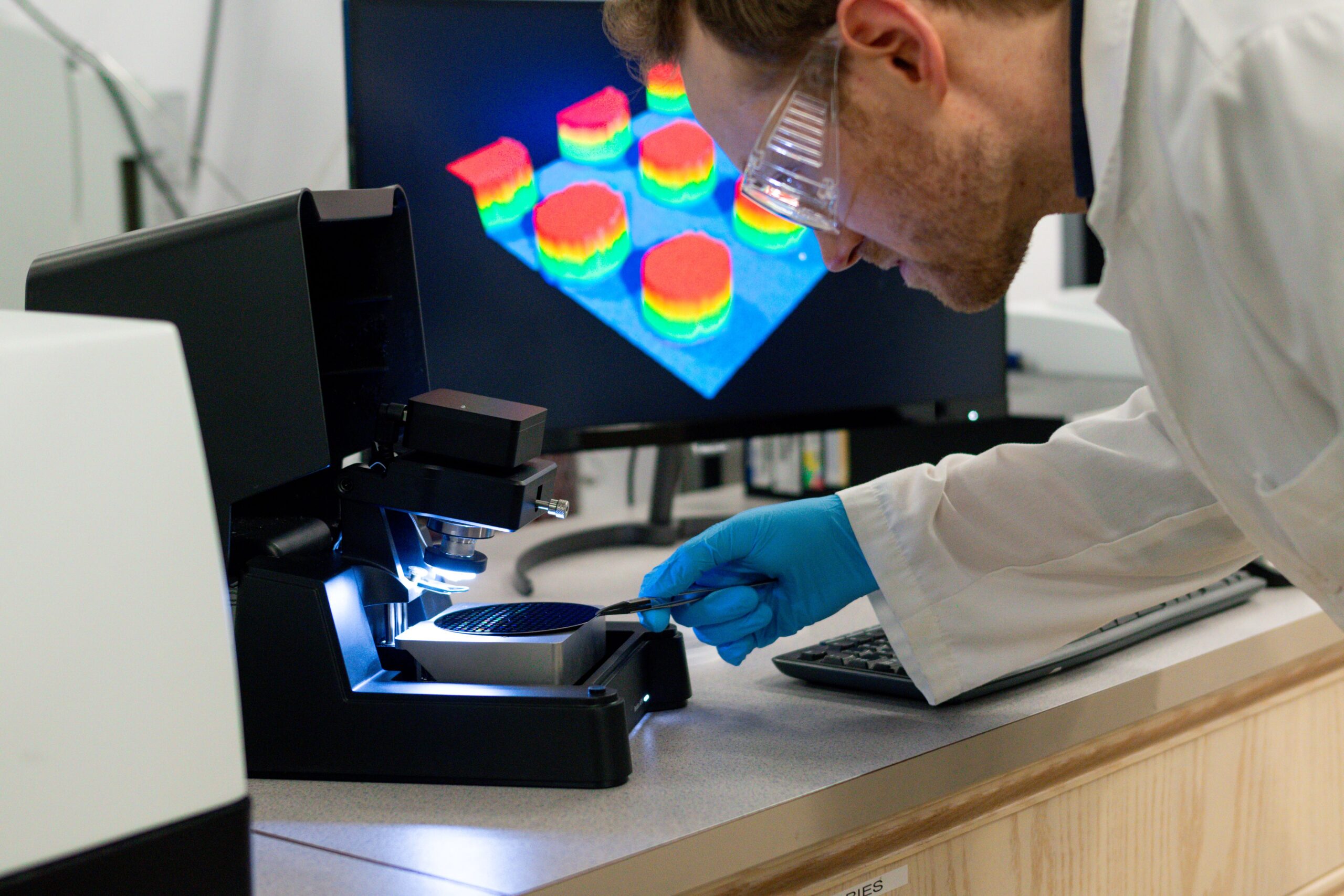
ICSPI Launches Redux AFM Capping Over 15 years of Collaboration with CMC
Waterloo-based ICSPI Corp. started with a vision to make atomic force microscopes fast, easy-to-use, powerful – and accessible
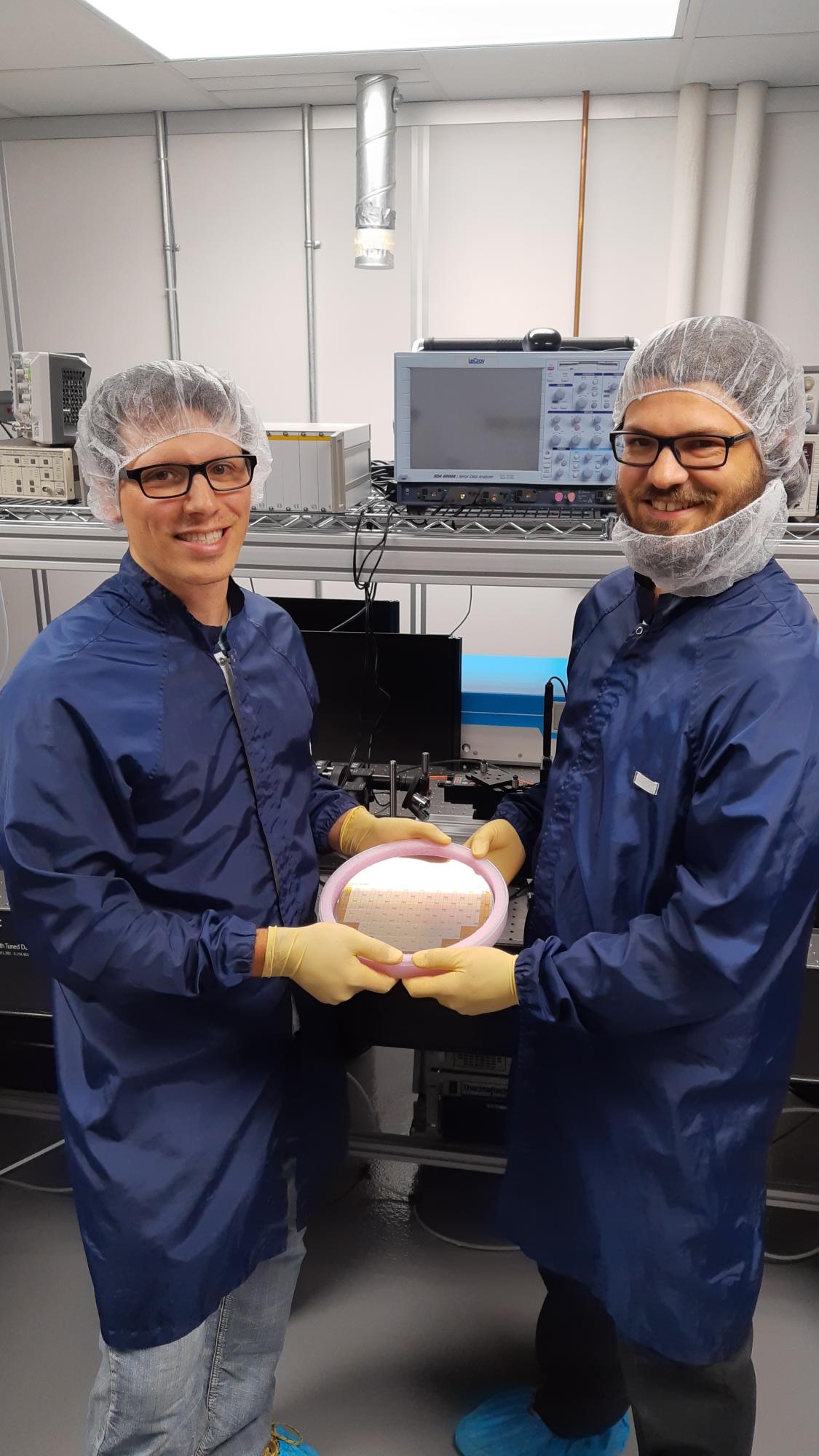
Université de Sherbrooke researchers collaborating on initiative that may reveal secrets of dark matter
Researchers at the Université de Sherbrooke (UdeS), supported by CMC Microsystems, are helping build sensors to detect ‘dark matter’ – the unknown substance that scientists think makes up about 25% of the universe.
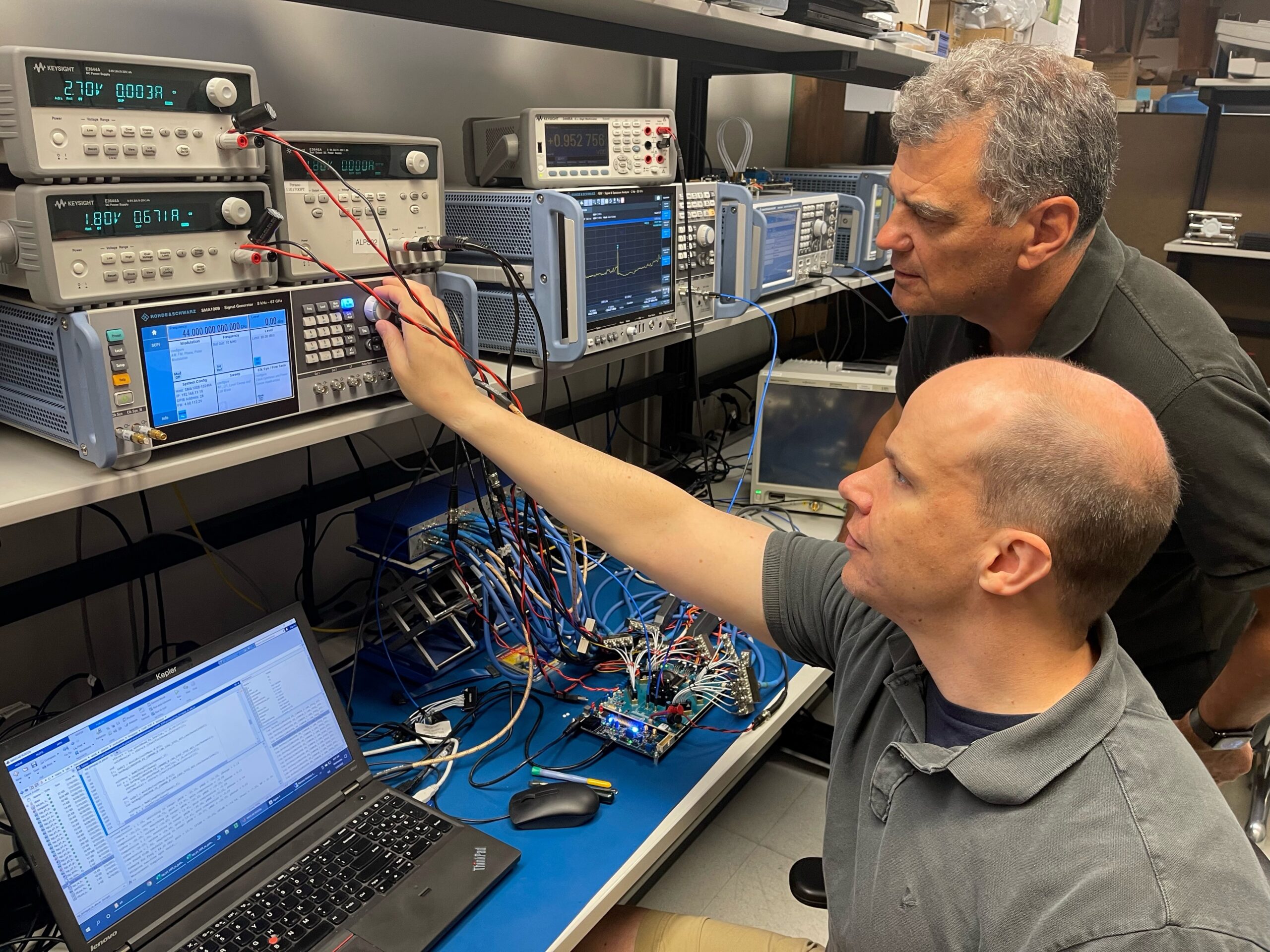
Peraso Inc. offers solutions that are ahead of the curve
Ron Glibbery, Peraso CEO (standing), Alexander Tomkins, Peraso CTO.
Canadian semiconductor company born out of CMC-enabled academic research is poised to play a big role in 5G wireless communications.
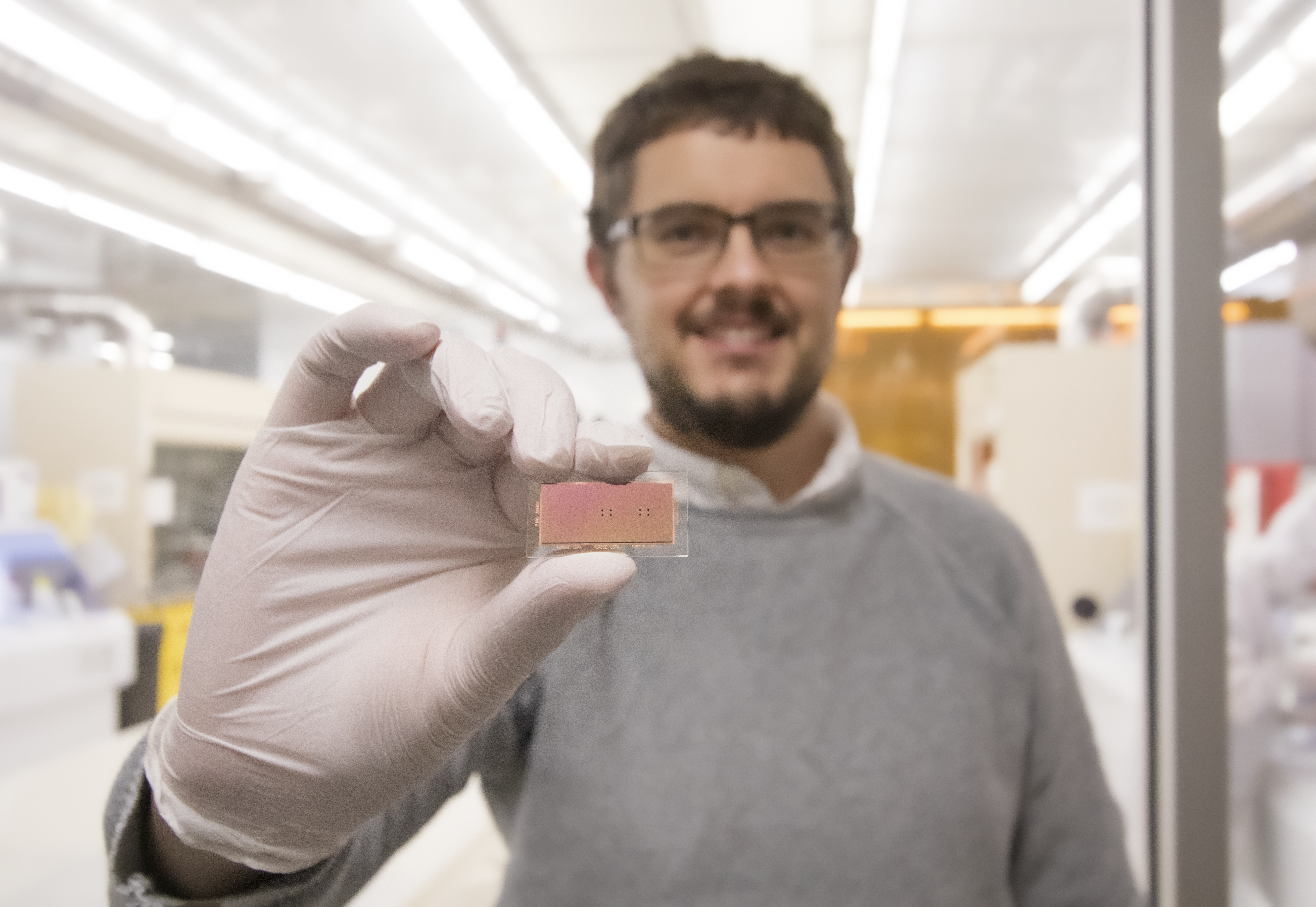
Greater Bandwidth for Next-Generation Mobile Communications
An Edmonton-based start-up is developing a light-activated switch that controls microwaves at high frequencies and could increase the bandwidth of mobile devices and other communications equipment.
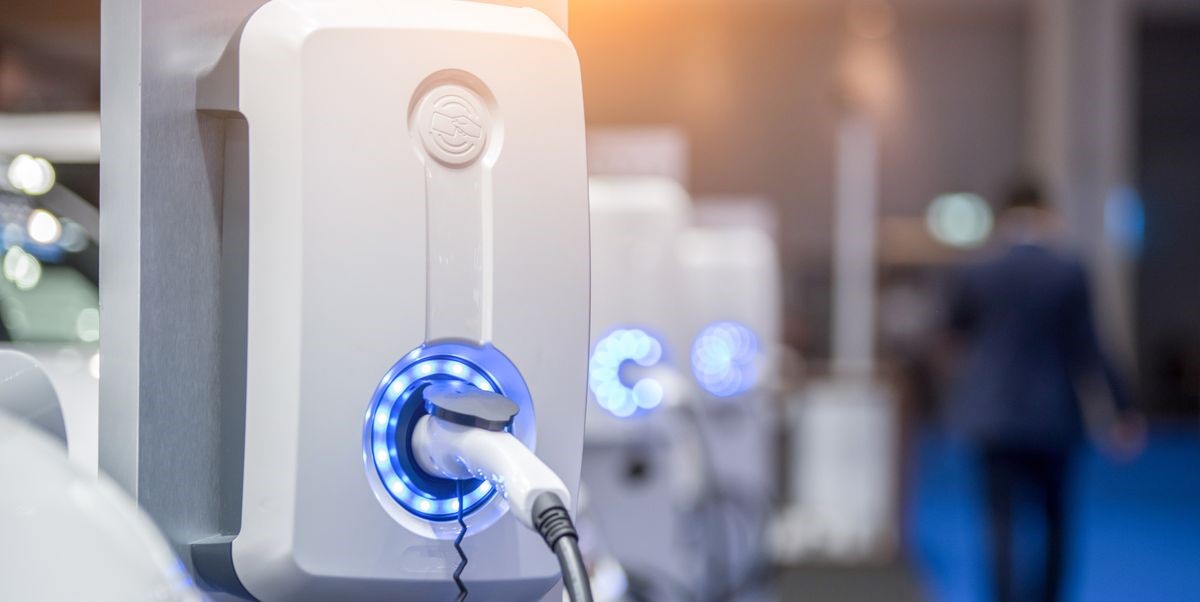
Making Better Batteries for the EV Revolution
A Université de Sherbrooke start-up has developed a thin, lightweight thermal management system that can improve battery performance in electric vehicles (EV) and other applications
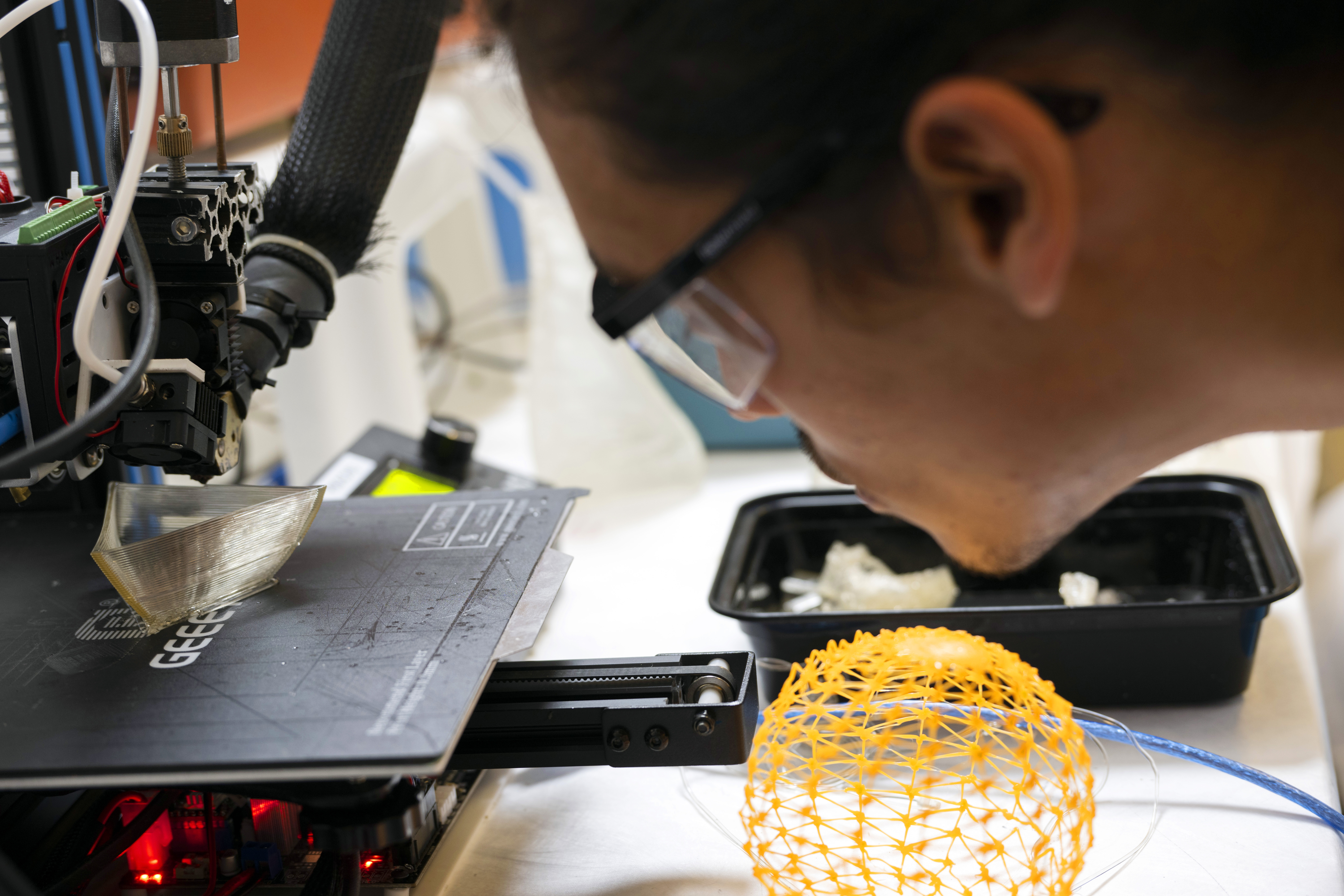
Game changing 3D industrial printing technology inspired by a 19th-century invention
Luka Morita inspects the performance of high flow rate printing of exceptionally soft rubbers useful in prosthetics and soft robotics
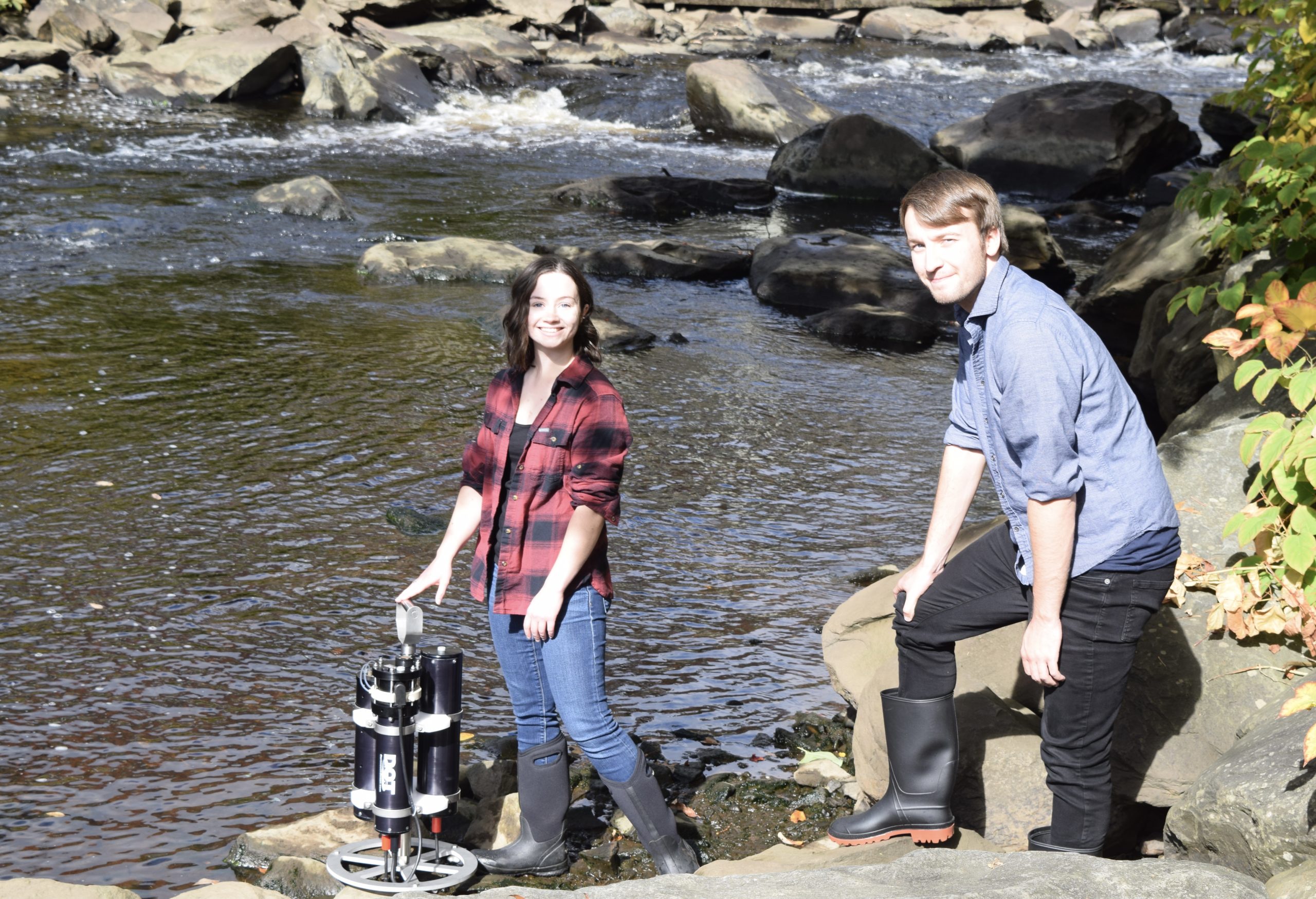
Electronic environmental explorers set sail
Connor Mackie & Edward Luy (courtesy Vincent Sieben)
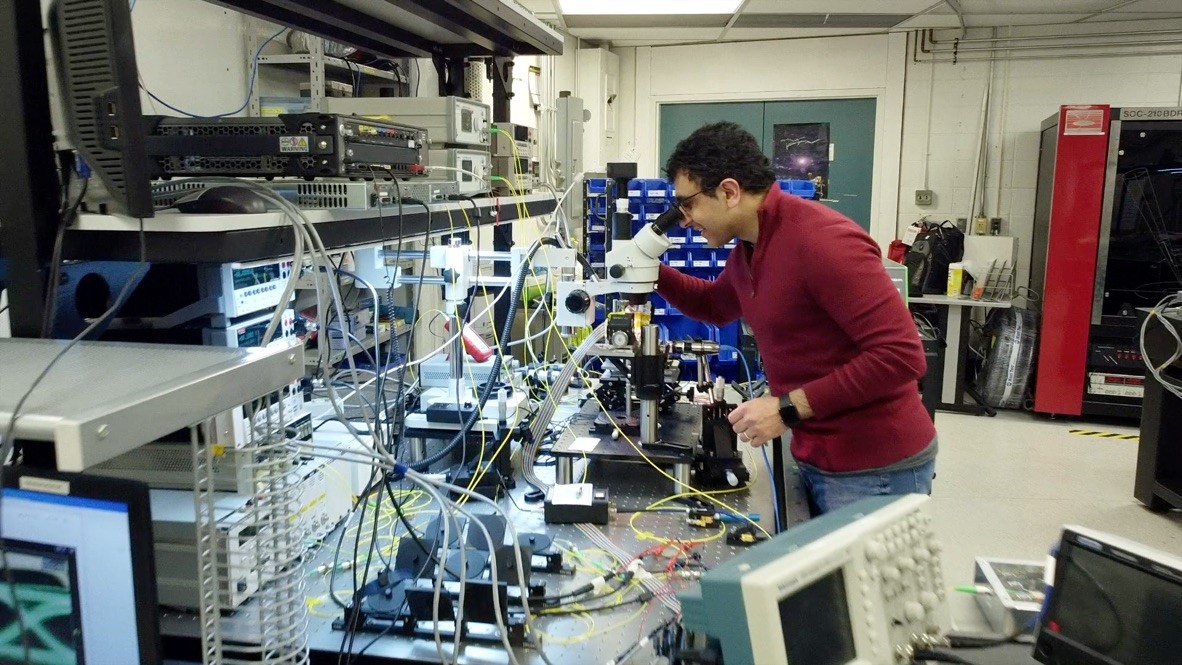
Hardware designs inspired by the human brain
Queen’s University’s Bhavin Shastri builds optoelectronic hardware inspired by the architecture of the brain and nervous system.
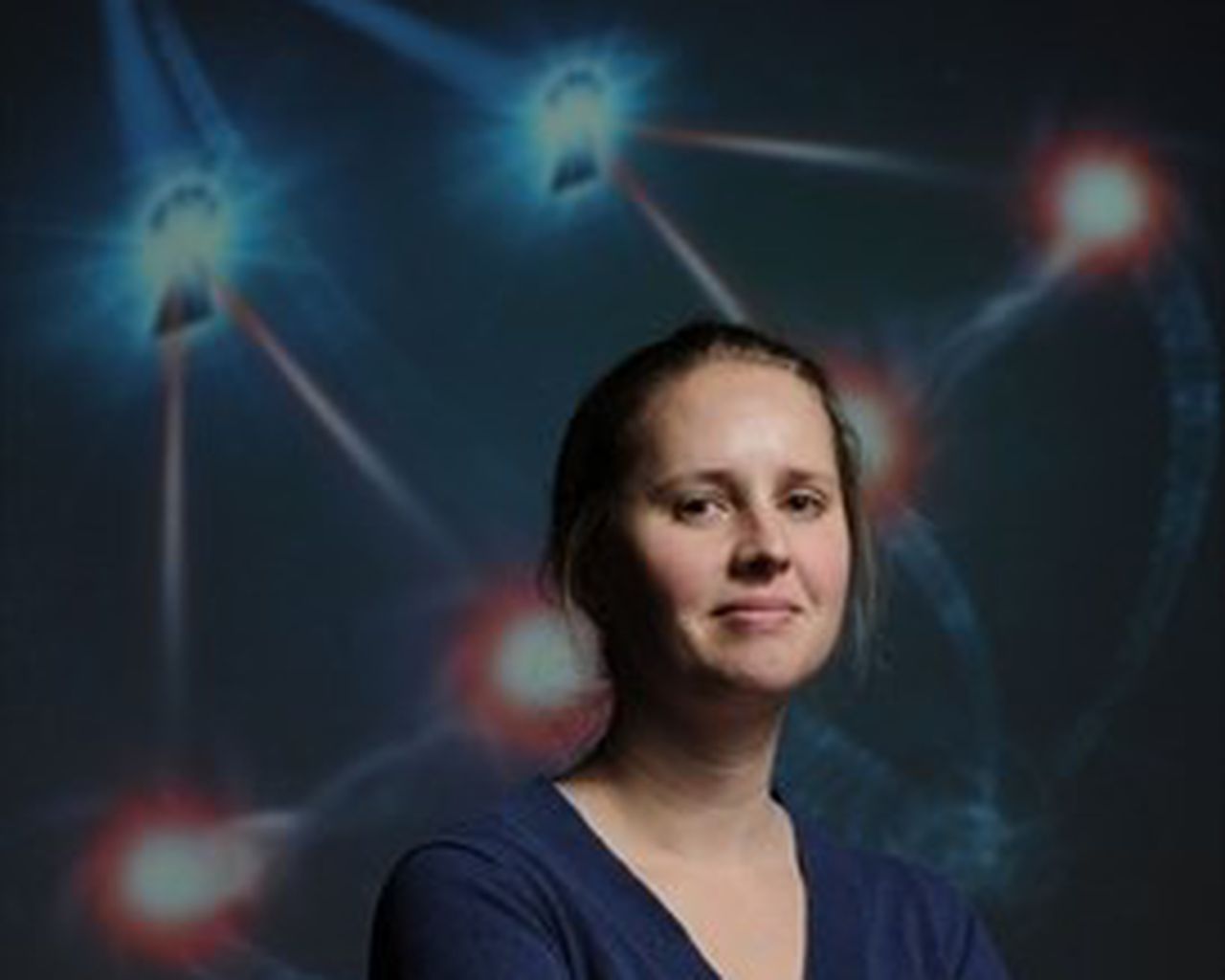
A quantum leap in cybersecurity
In the post-quantum world, the password authentication schemes that companies and consumers rely on for secure transactions will be more vulnerable to attack. A team of researchers at the University of Ottawa is working on a way to foil cybercriminals in the not-so-distant future.
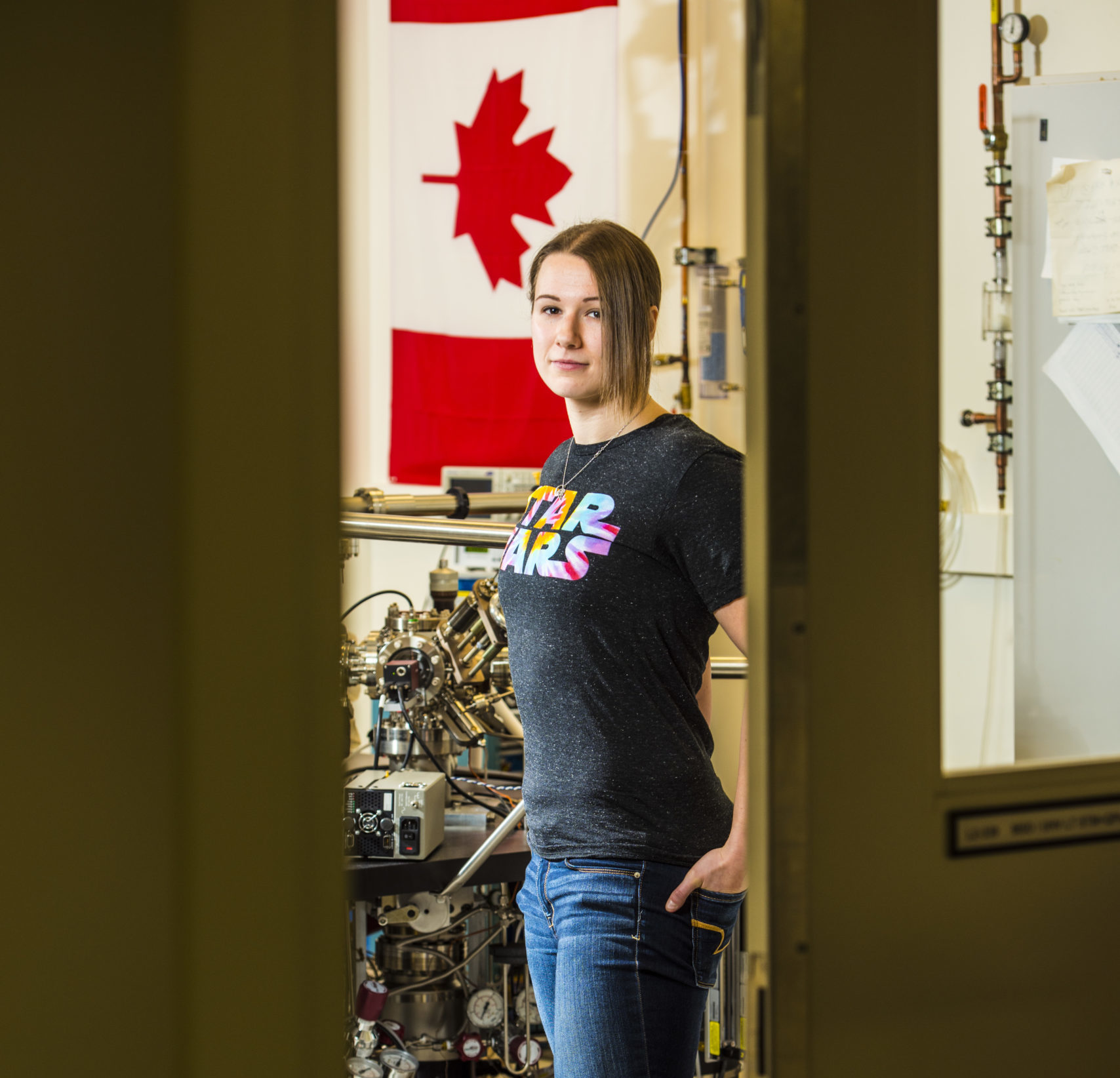
Towards an energy efficient future – at the atomic level
Taleana Huff has won the 2021 CMC Microsystem’s Douglas R. Colton Medal for Research Excellence for work that lays the foundation for computers and mobile phones that use 100 times less energy.
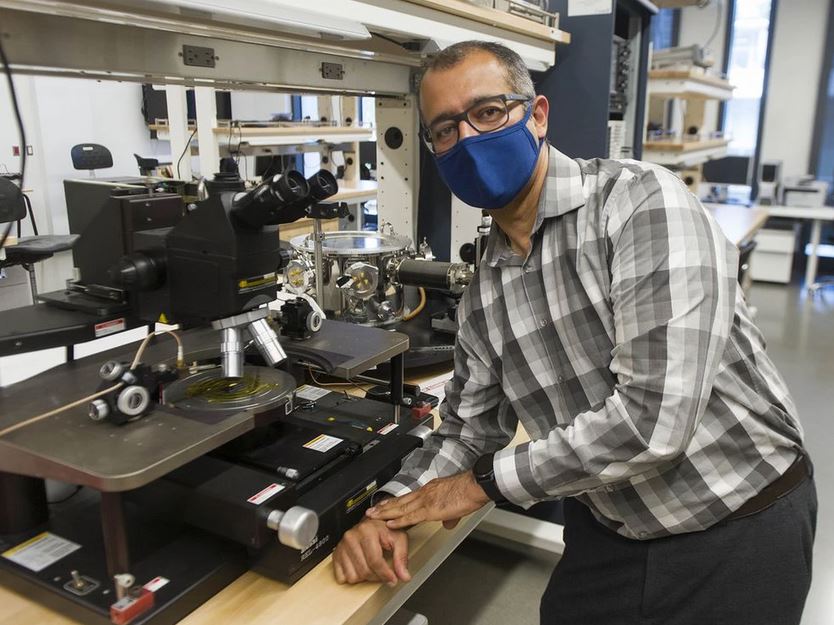
Sensors headed to the moon
Behraad Bahreyni’s quest for the moon began with a project that took him in the opposite direction – the depths of the Atlantic Ocean.
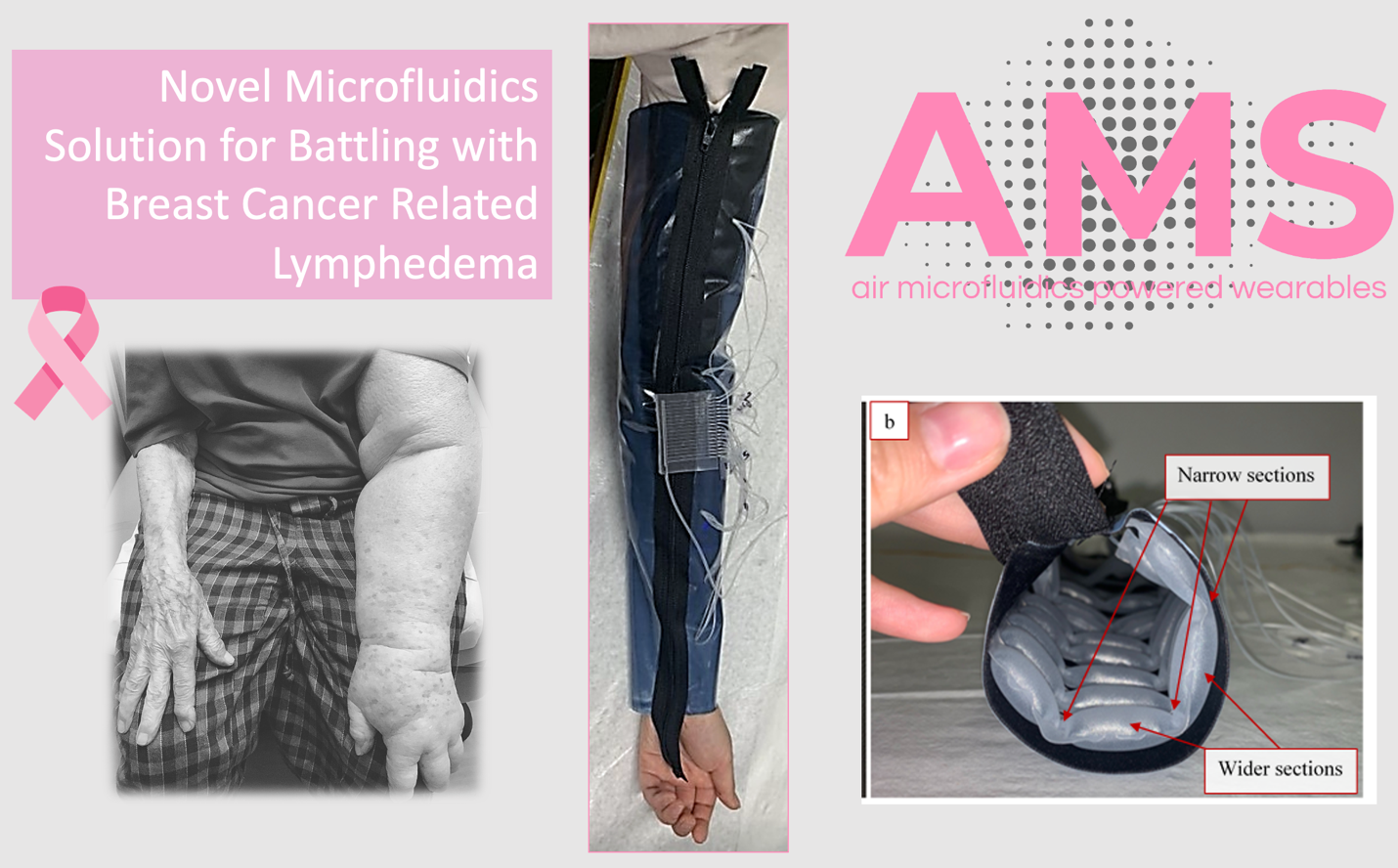
Using microfluidics to help breast cancer survivors heal and recover
Two University of Waterloo researchers are applying their work in microfluidics to help breast cancer survivors cope with collateral damage from their treatment.
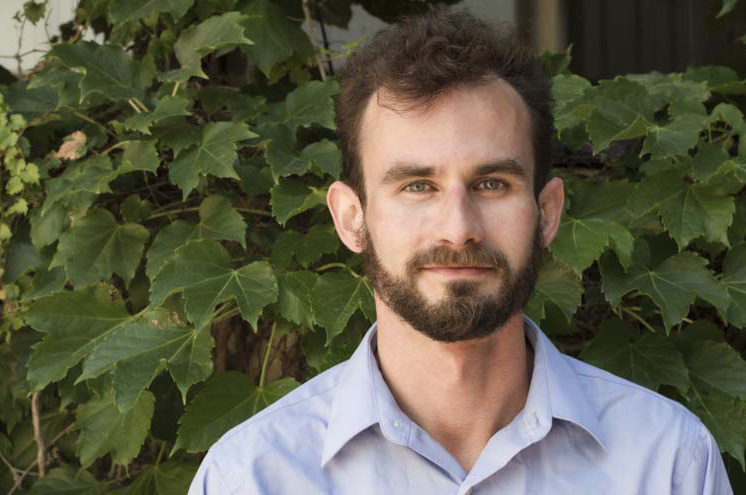
Advancing nanopore research into the mainstream
Scientists are often asked about their ‘eureka moment’ — the flash of insight that led to a discovery. But sometimes those moments are made possible by a much more prosaic reality: having the right tool or method at hand to spark those unexpected ideas, and enable their exploration.
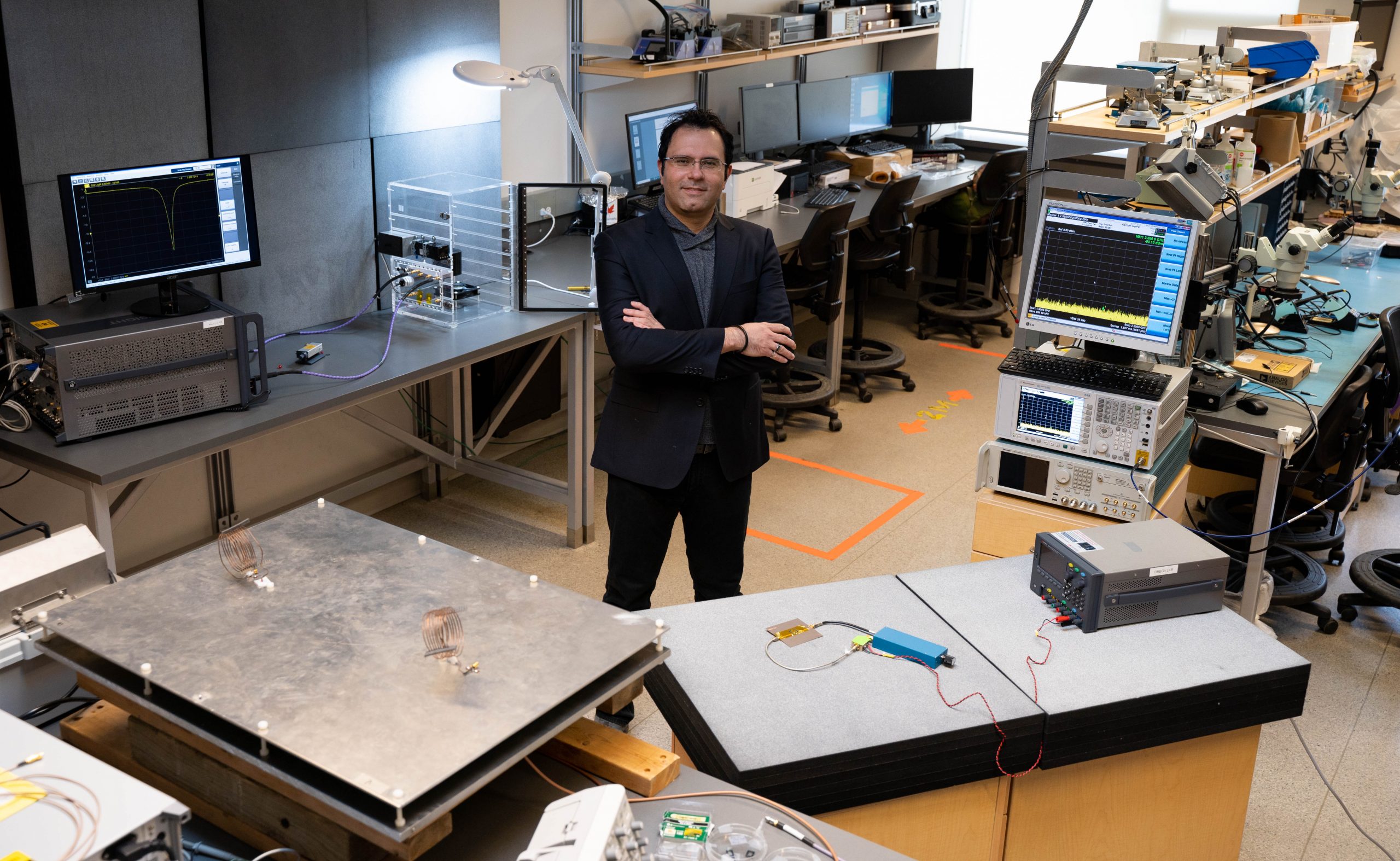
Breaking the ice with microwave sensors
Sophisticated sensors have become embedded in virtually every aspect of our daily environment. Yet today, airplane pilots and wind turbine technicians still largely rely on visual inspection to assess ice buildup, a potentially catastrophic condition.
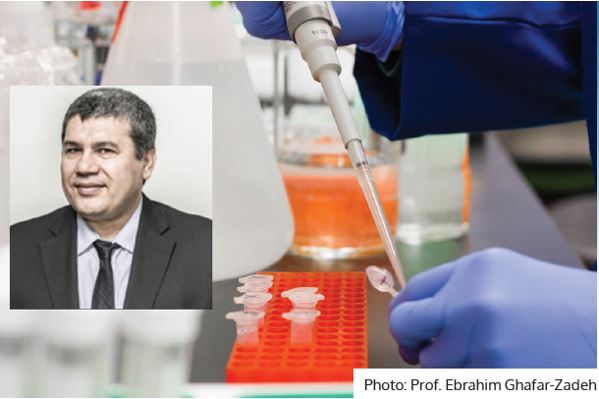
On the road to success
Prof. Ebrahim Ghafar-Zadeh and his team are on the cusp of changing how we test for COVID-19. They are using cutting edge technologies in machine learning and microsystems to develop the simplest, most efficient test possible.
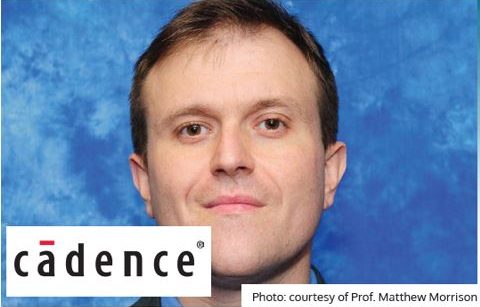
Pandemic sparks game-changing approach to hardware training
Long before the COVID-19 pandemic shuttered research labs around the world, University of Notre Dame’s Matthew Morrison was thinking about a different kind of threat: the looming limits of Moore’s Law, which pose critical problems for the development of more powerful, ever-smarter computer hardware.
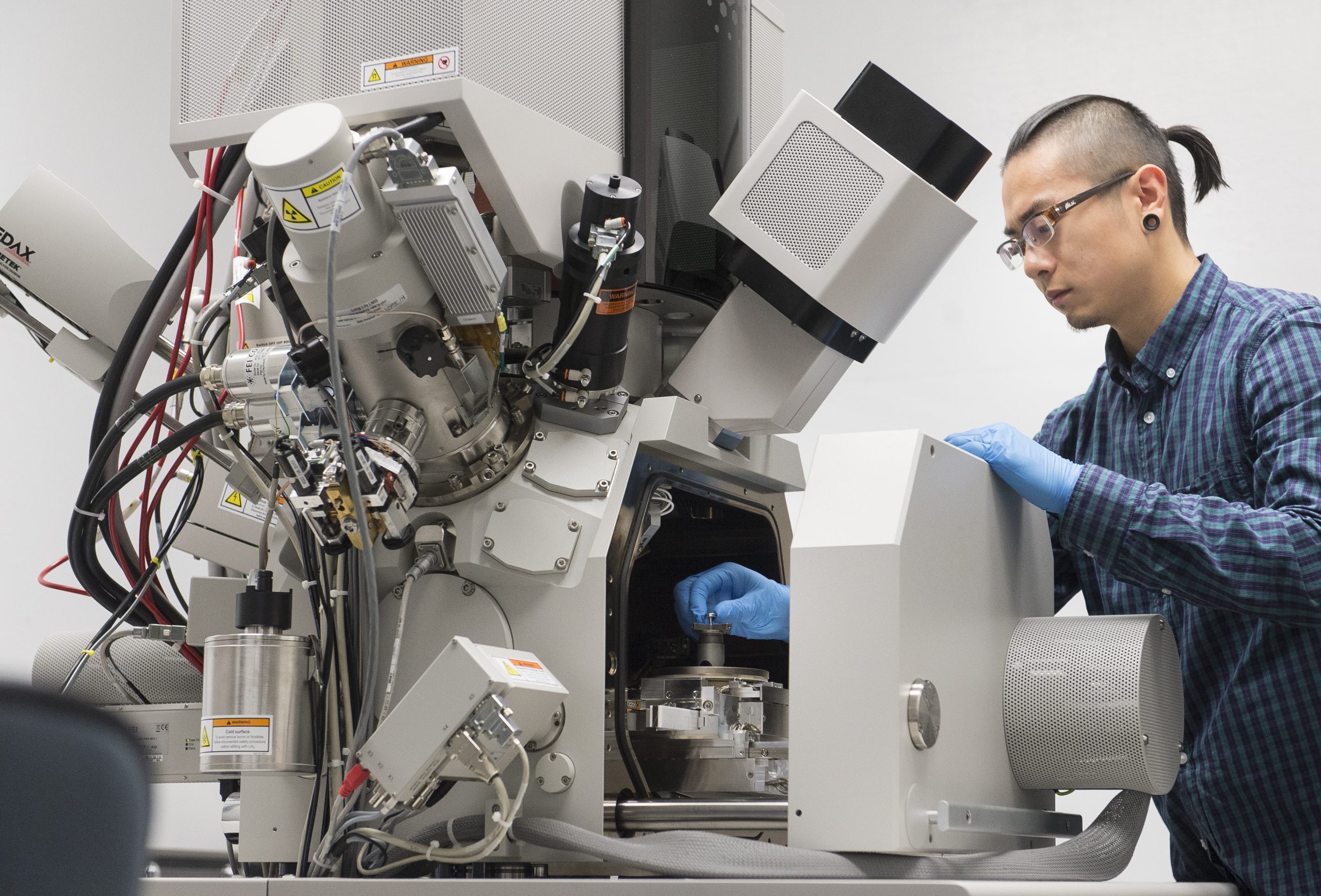
A platinum-powered boost for fuel cells
Dr. Byron Gates and Dr. Michael Paul (pictured here) found a way to bring us closer to more efficient and affordable hydrogen fuel cell technology.
How student training drove Canada’s success in silicon photonics
A decade after creating the world’s first graduate-level course for designing and making nanophotonic integrated circuits, UBC Professor Lukas Chrostowski enjoys seeing his students continue to push the limits of innovation in this expanding technology.
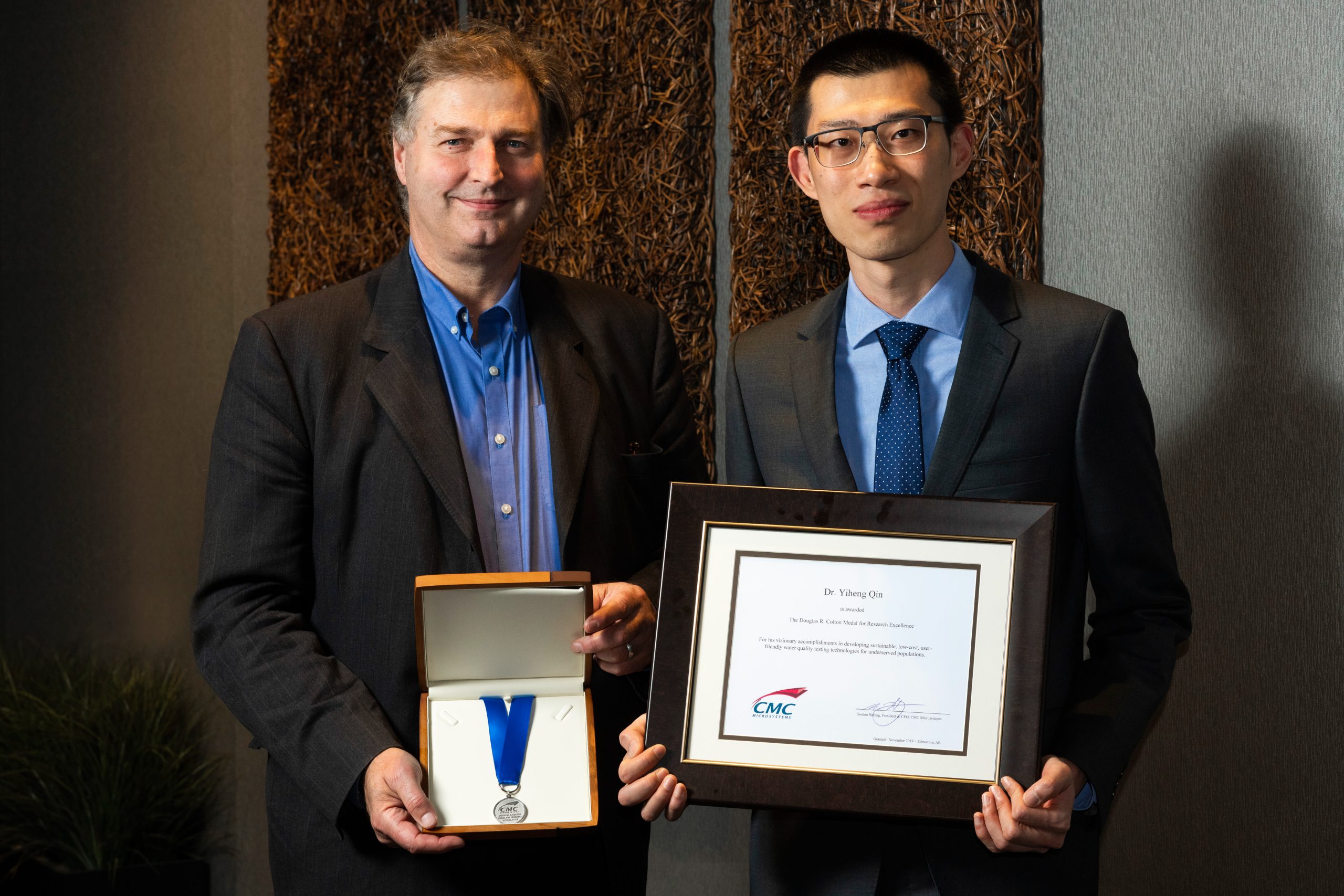
Low-cost sensors yield high-impact technology
Dr. Yiheng Qin’s development of a novel inkjet printing process offers industry a low-cost method for manufacturing highly accurate electrochemical sensors for water monitoring.
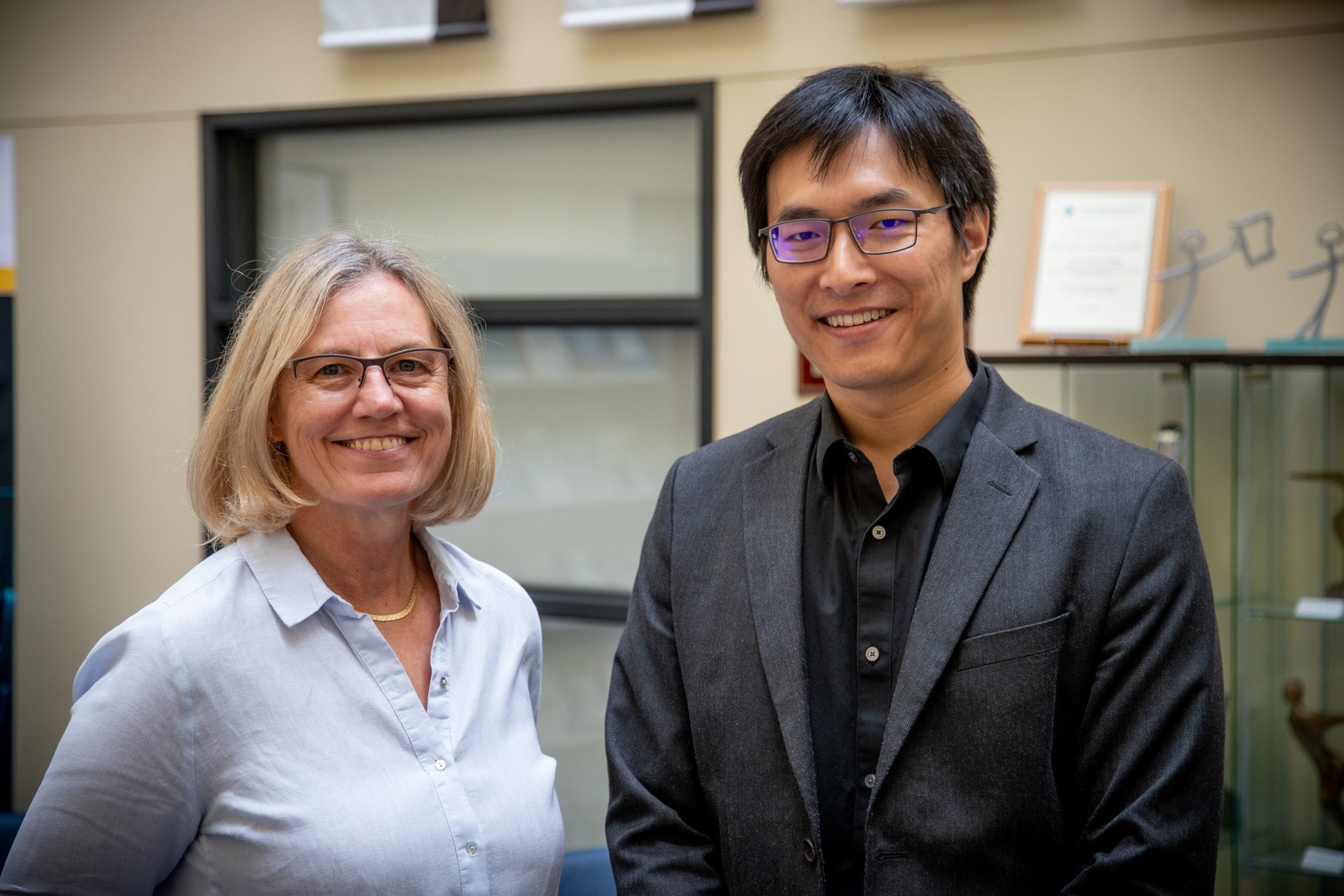
Commonplace material, extraordinary performance
An all-silicon modulator developed by Université Laval professors Leslie Rusch (left) and Wei Shi achieved the fastest-ever transmission on silicon photonics. Their low-cost, low-energy component, produced through standard foundry processes, solves a significant challenge in next-generation semiconductor design.
Photo credit: Reinier deSmit
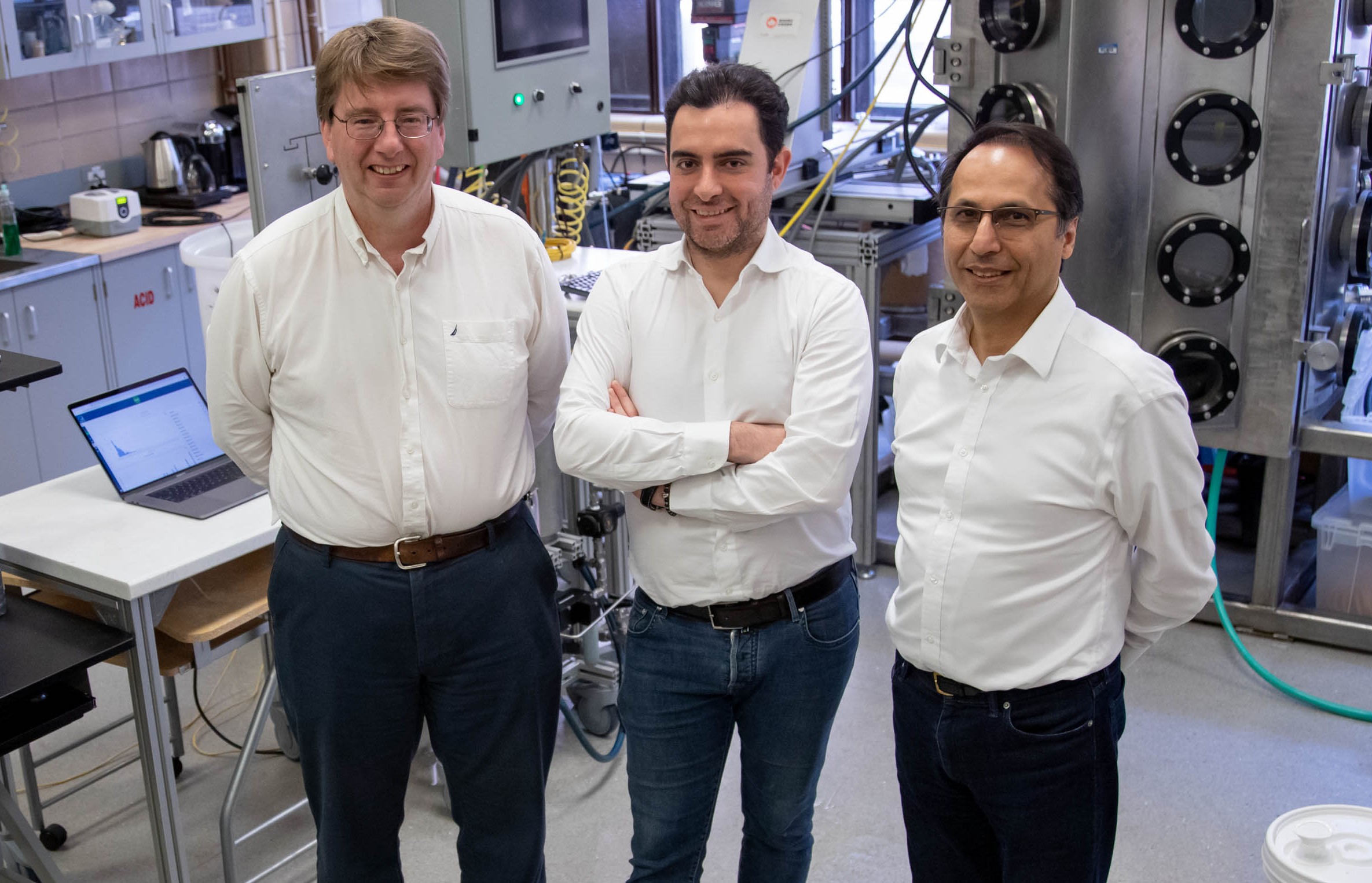
Sizing up an industrial solution
Dr. Pierre Sullivan, left, with Dr. Amirreza Amighi (centre) and Dr. Nasser Ashgriz combined imaging, machine-learning, and statistical analytics to bring quality control to the tiny particles emitted by spray nozzles in a wide variety of industrial applications.
Photo credit: Reinier deSmit
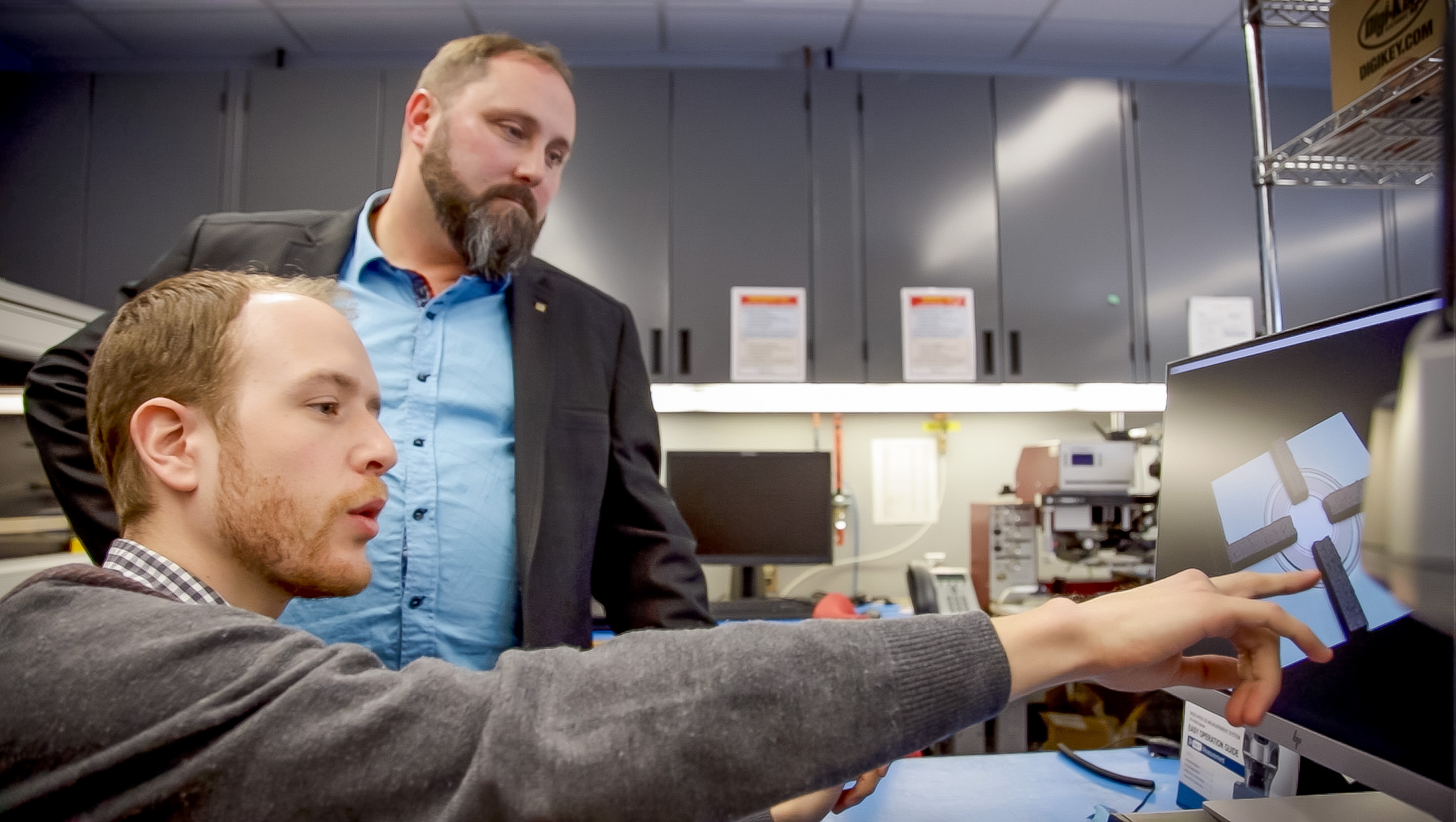
Adding a new dimension to light detection
Ultra-sensitive detectors for capturing light signals developed by Université de Sherbrooke’s Jean-François Pratte and his team, including Frédéric Vachon, foreground, are advancing the power and sophistication of a broad range of imaging technologies, from PET scanners to big-science endeavours such as neutrino detection.
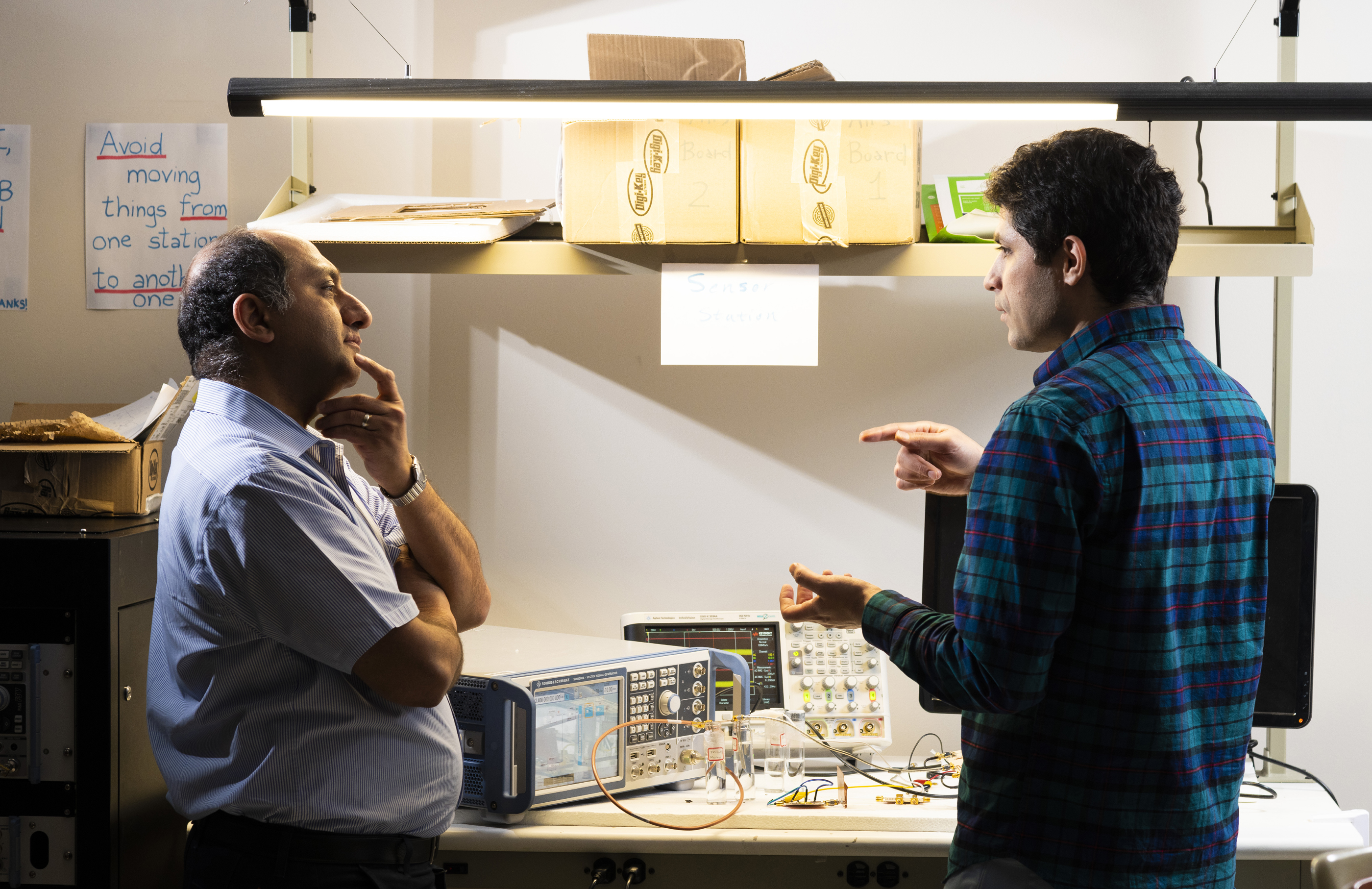
Creating intelligent antennas for the Internet of Things
University of Alberta professor Pedram Mousavi (left) and research scientist Rashid Mirzavand have developed a self-powered sensor for smart antennas, capable of operating in challenging settings.
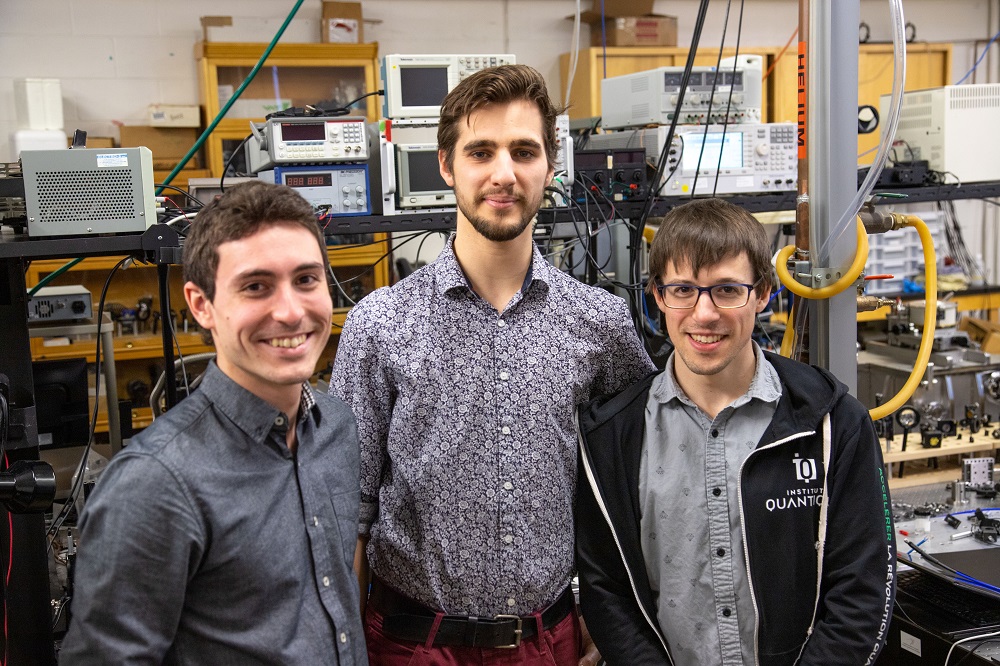
A gem of a technology
Dr. David Roy-Guay, right, is working with students Vincent Halde (centre) and Olivier Bernard to miniaturize his novel, diamond-based magnetometer prototype. The quantum sensor technology shows promise in a wide variety of applications, including research in outer space.
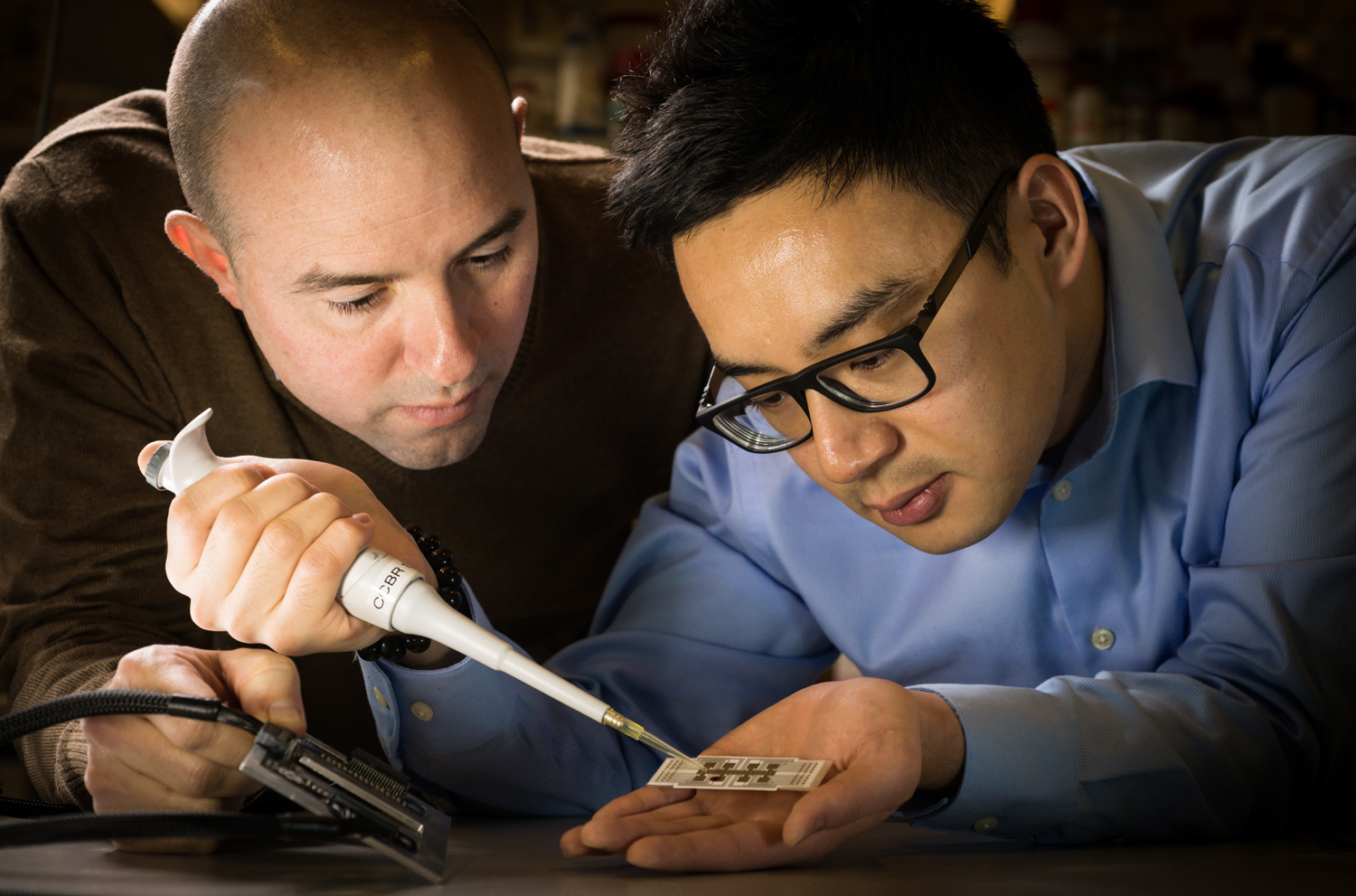
Monitoring disease with microfluidics
Alphonsus Ng, right, and his University of Toronto supervisor Aaron Wheeler used digital microfluidics to develop a rapid, simple diagnostic tool that can transform disease tracking in low-resource environments such as refugee camps.
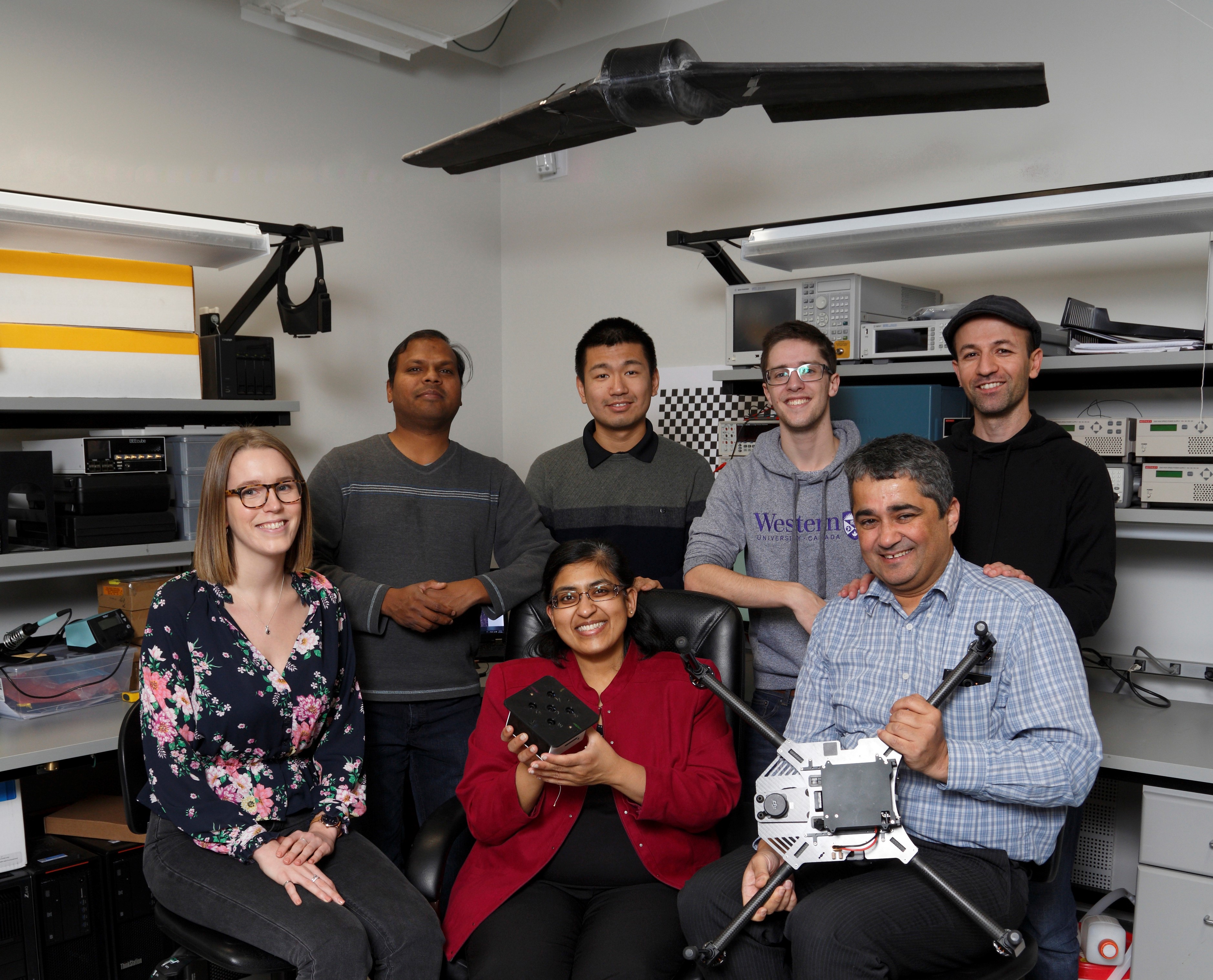
Seeing modern agriculture in a new light
Jayshri Sabarinathan, Professor of Electrical and Computer Engineering at Western University, has used her experience with microsensors and nanofabrication to develop higher-performing multi-spectral cameras for agricultural monitoring in collaboration with industry partner A&L Canada Labs.
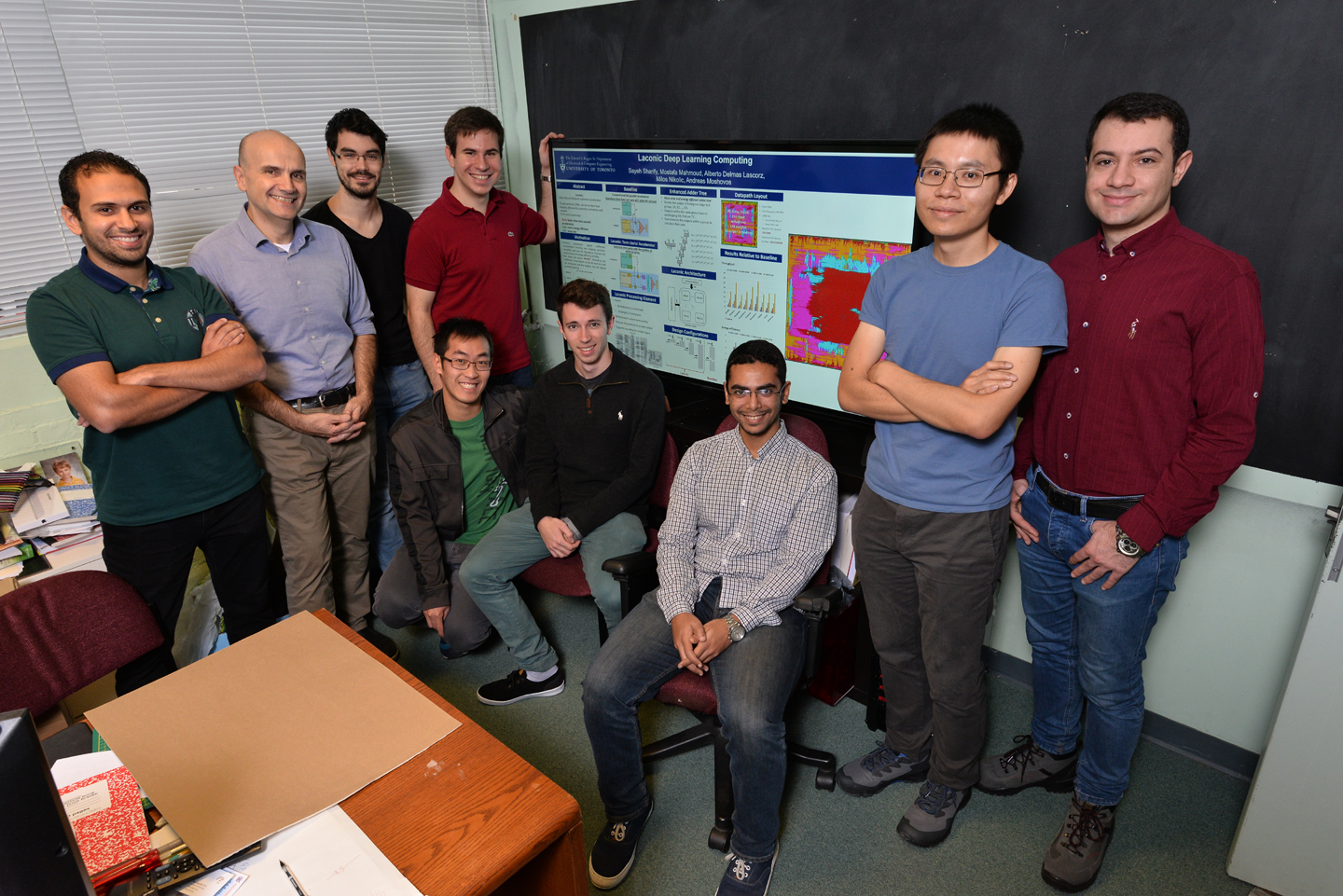
Deep learning, big impact
Building on his groundbreaking work in computer hardware innovation, Andreas Moshovos (second from left) of University of Toronto is leading a national network of university researchers focused on advancing machine learning into new levels of function akin to human capabilities of hearing, sensing or reading.
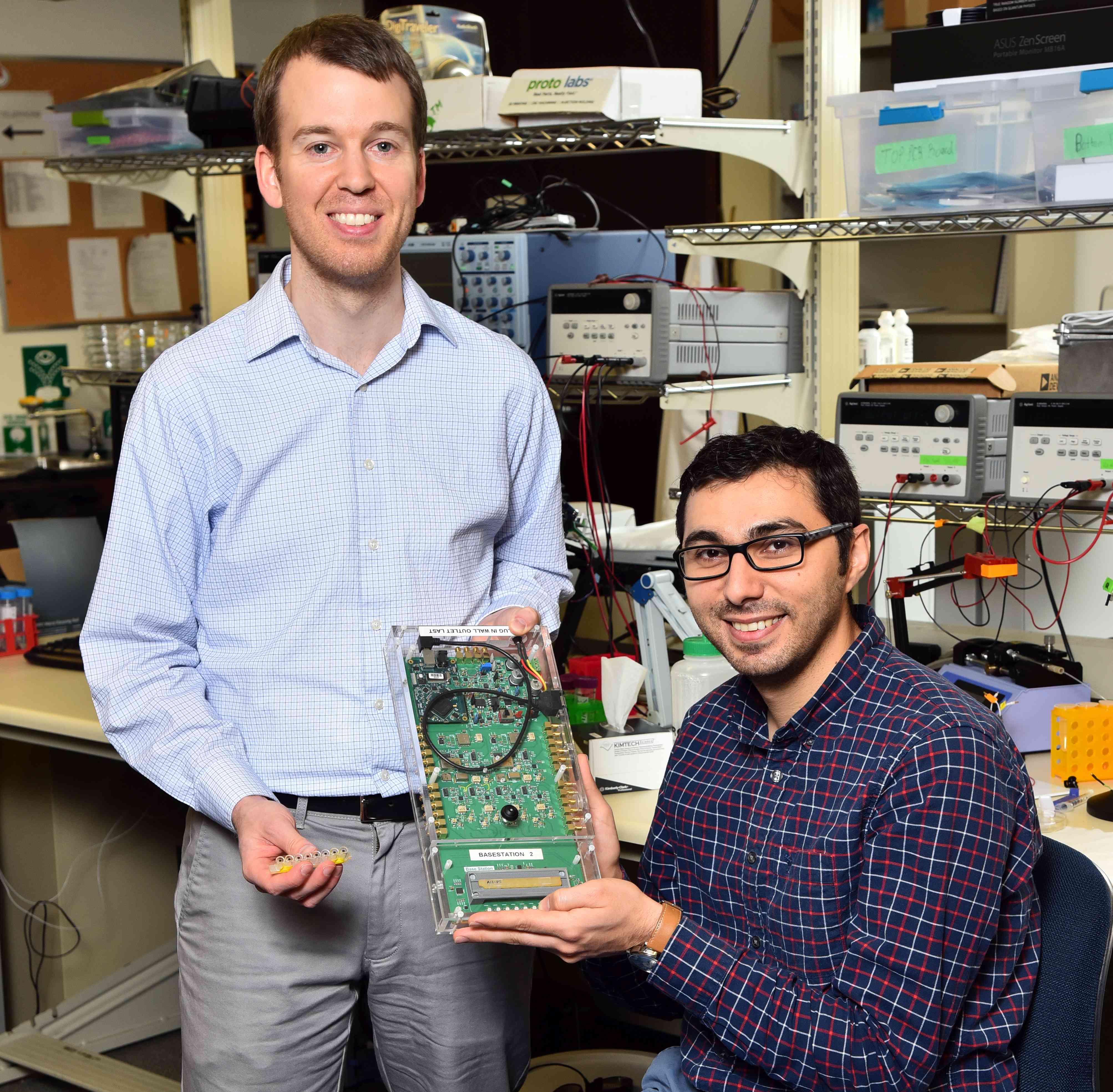
A new approach to an old cure
Drs. Brendan Crowley (left) and Enver Kilinc, founders of Micromensio, worked with University of Toronto researchers to develop a low-cost, rapid sensing technology that targets bacterial infections.
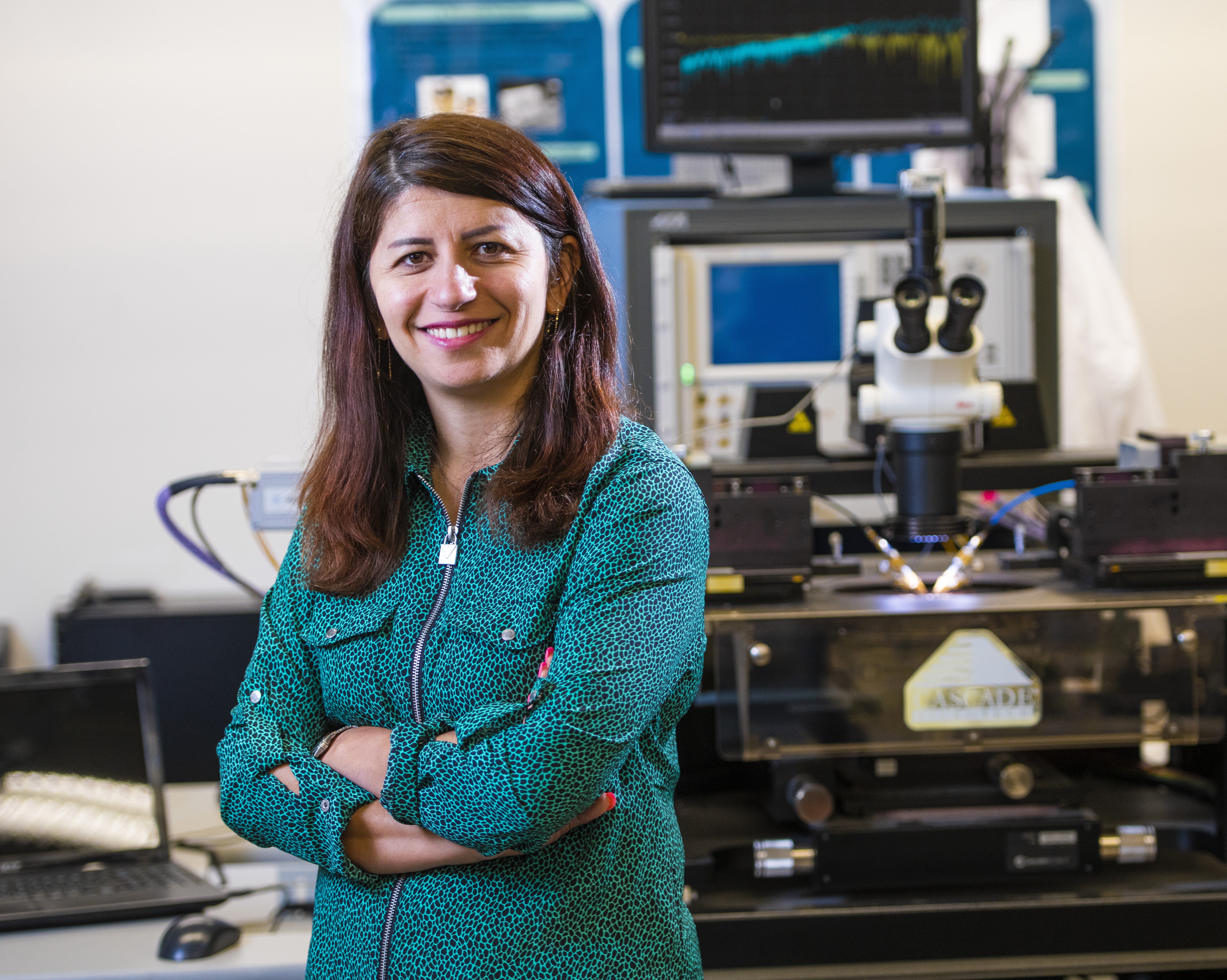
Controlling waves with MEMS
Prof. Mojgan Daneshmand’s research in micro-electromechanical systems and radio frequency is advancing innovations in a wide variety of smart technologies.
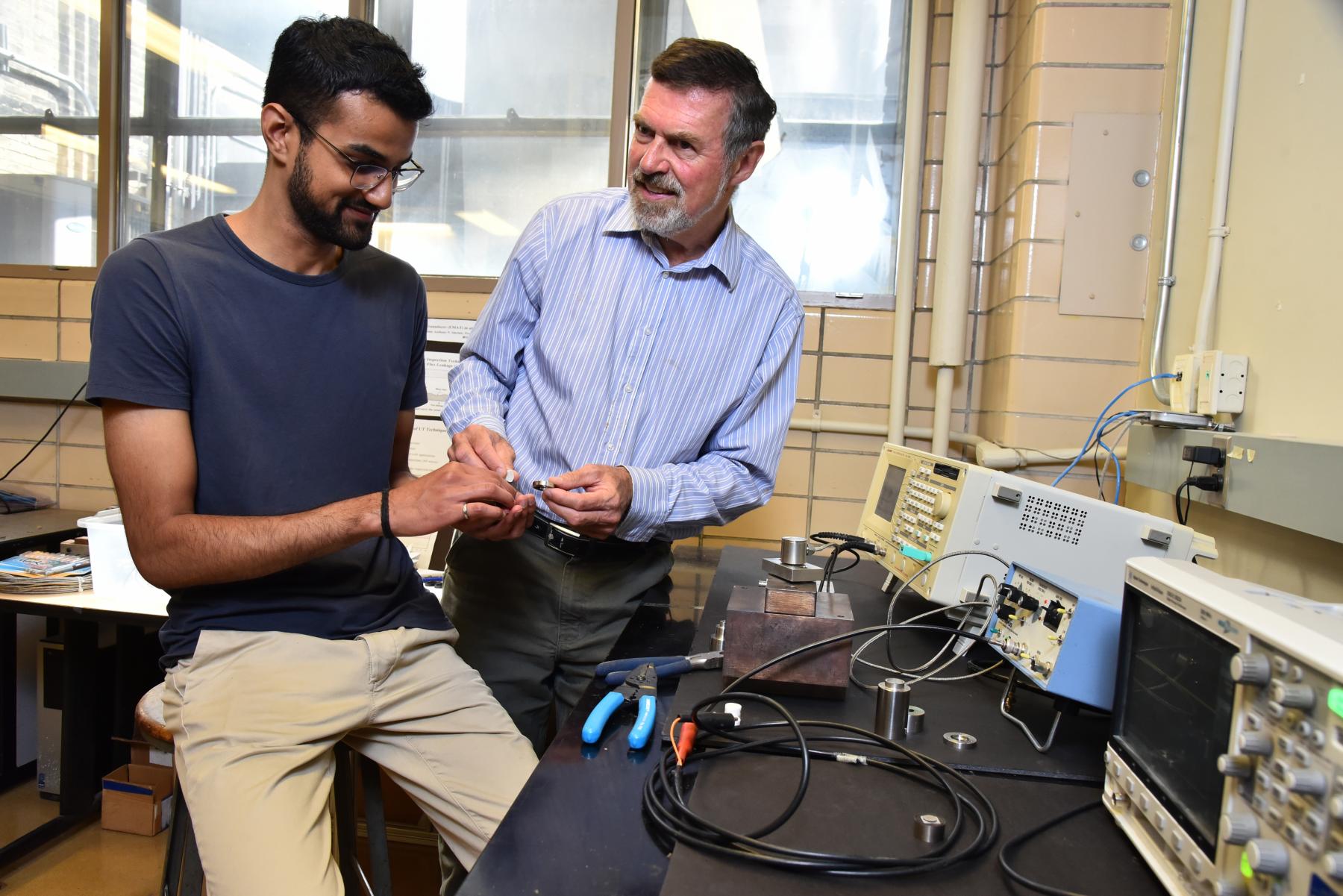
Breaking sound barriers
Dr. Tony Sinclair (right), University of Toronto, and Master’s student Neelesh Bhadwal, work with business partners on ways to improve the precision and reliability of ultrasonic imaging used to monitor the integrity of critical infrastructure.
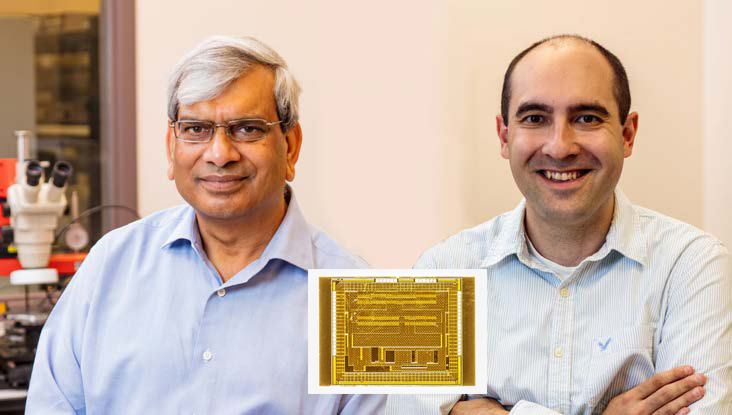
Taking power conversion to a new level
A novel power converter developed by Queen’s University PhD candidate Marko Krstic (right) under the supervision of Dr. Praveen Jain, Canada Research Chair in Power Electronics, offers significantly higher efficiency than commercially available chips.
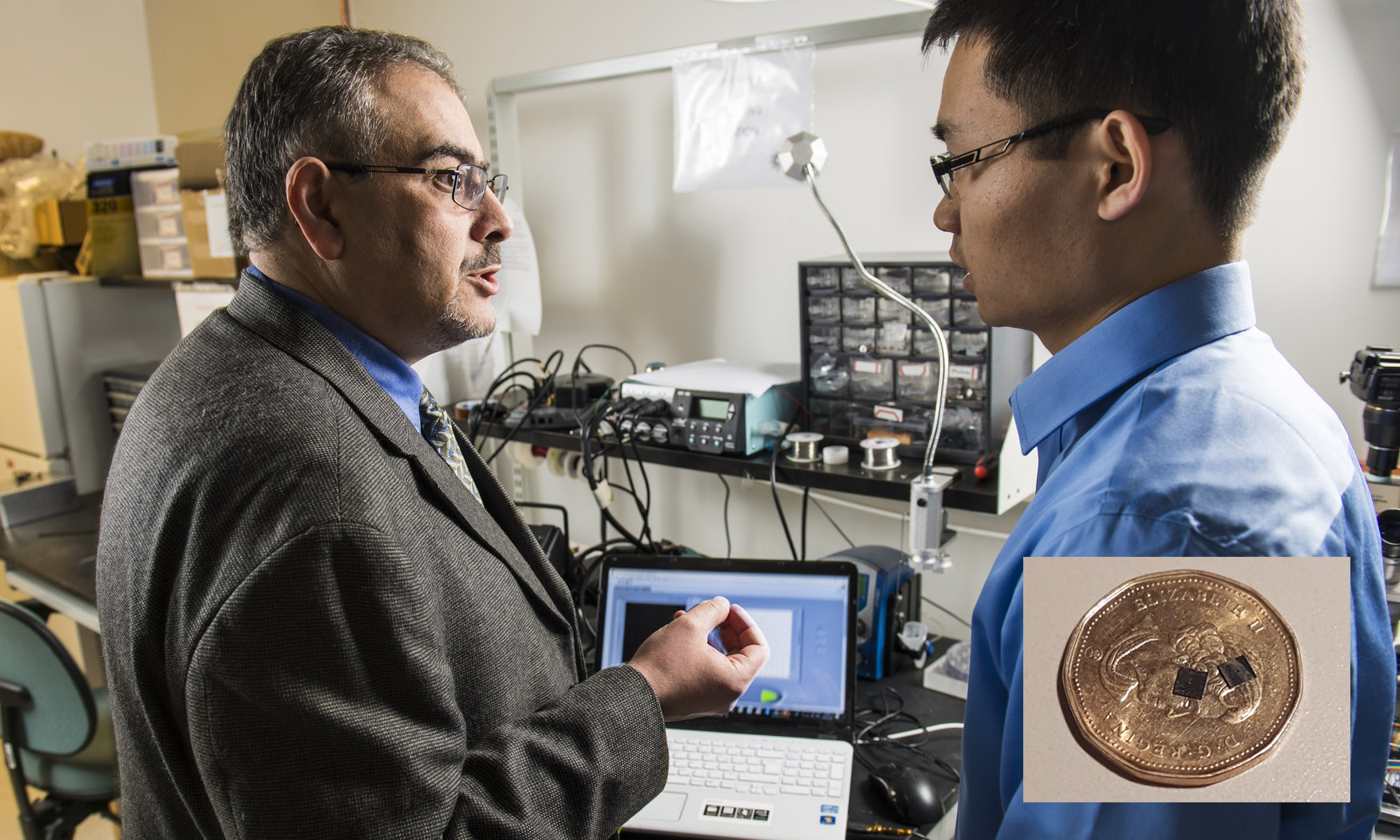
Unlocking the power of 3D touch
University of Alberta Professor Walied Moussa and graduate student Shichao Yue have taken touchscreen capability to a new level through their development of a “Real Touch” 3D sensor array (inset) that can measure the full range of forces on a surface with unprecedented sensitivity.
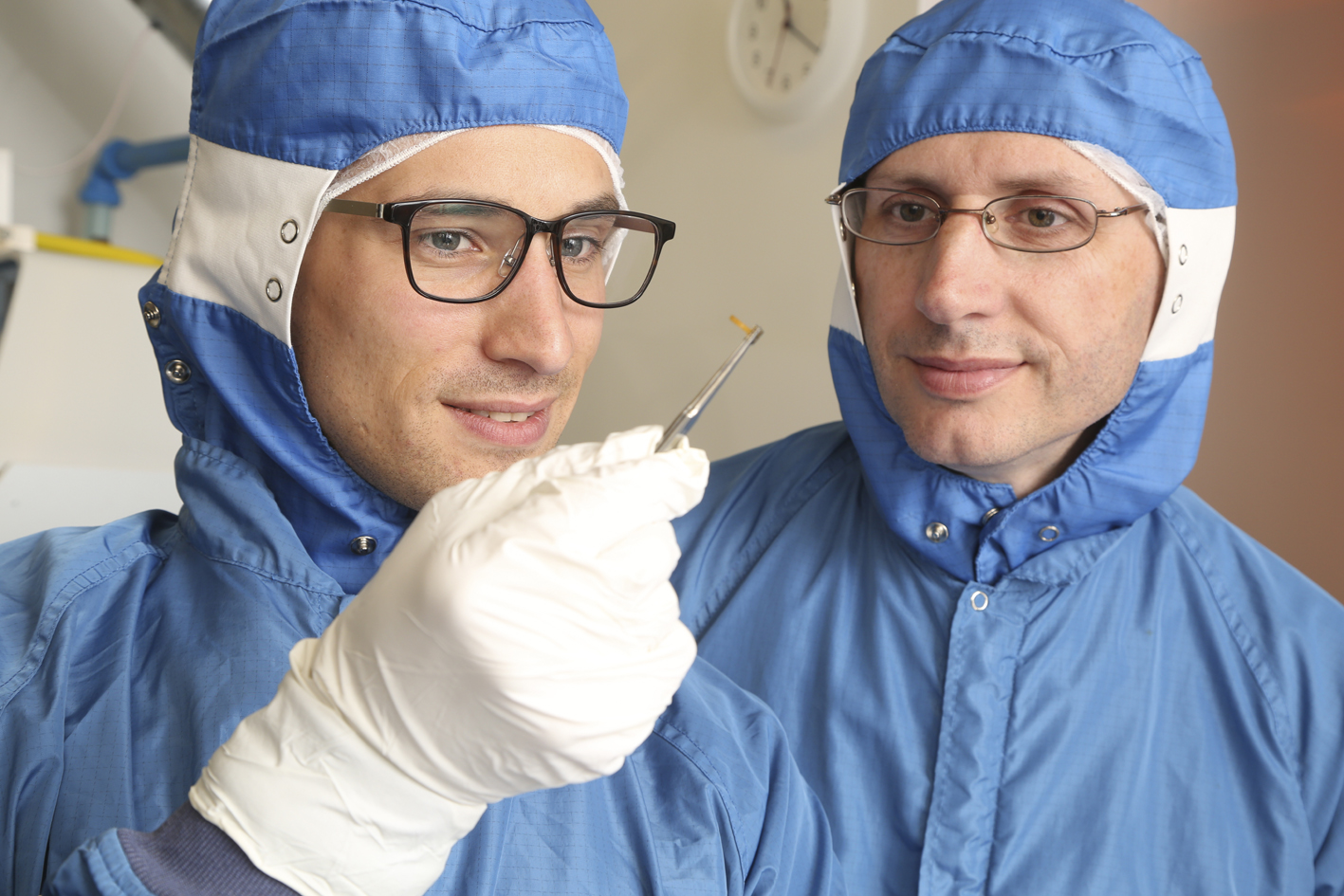
Nano-micro electrode opens new frontiers in brain research
A nano-edge microelectrode developed by University of Calgary researchers Colin Dalton (right) and Pierre Wijdenes is taking brain research to a new level.
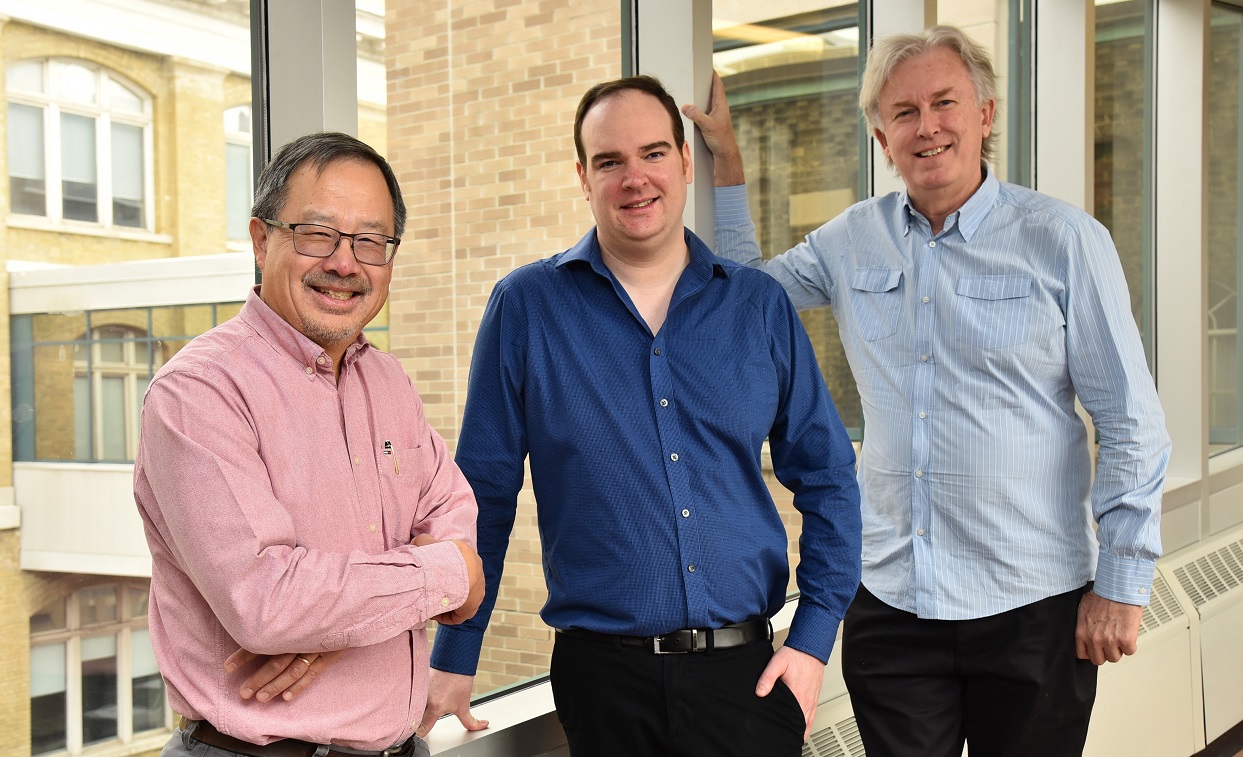
Building for the future: YetiWare takes on the heterogeneous computing challenge
The function of computers depends on a myriad of intricate interactions between the hardware and software inside the machine. As computers become faster, more powerful and increasingly sophisticated, so too does the complexity of those hardware-software “conversations” – and that poses a significant problem for computer engineers.
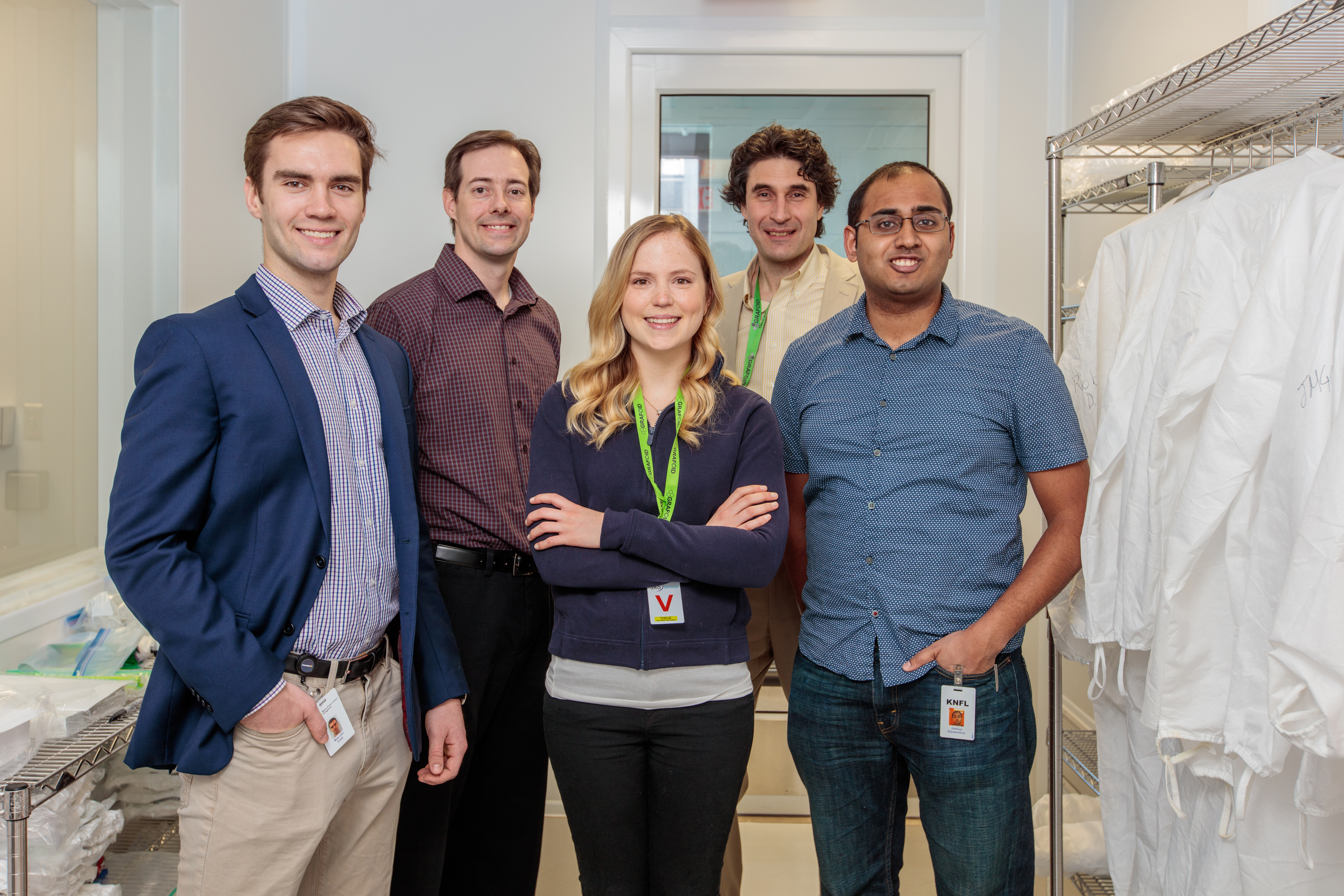
Nano research yields sensing breakthrough
Nanofabrication capabilities helped Queen’s University researchers and their graduate students develop a novel, highly sensitive portable biosensor that can be manufactured simply and inexpensively. Their technology now forms the basis of an award-winning startup company, Spectra Plasmonics. Shown left to right: Malcolm Eade, Spectra CEO; Graham Gibson, Hannah Dies, Aris Docoslis and Josh Raveendran.
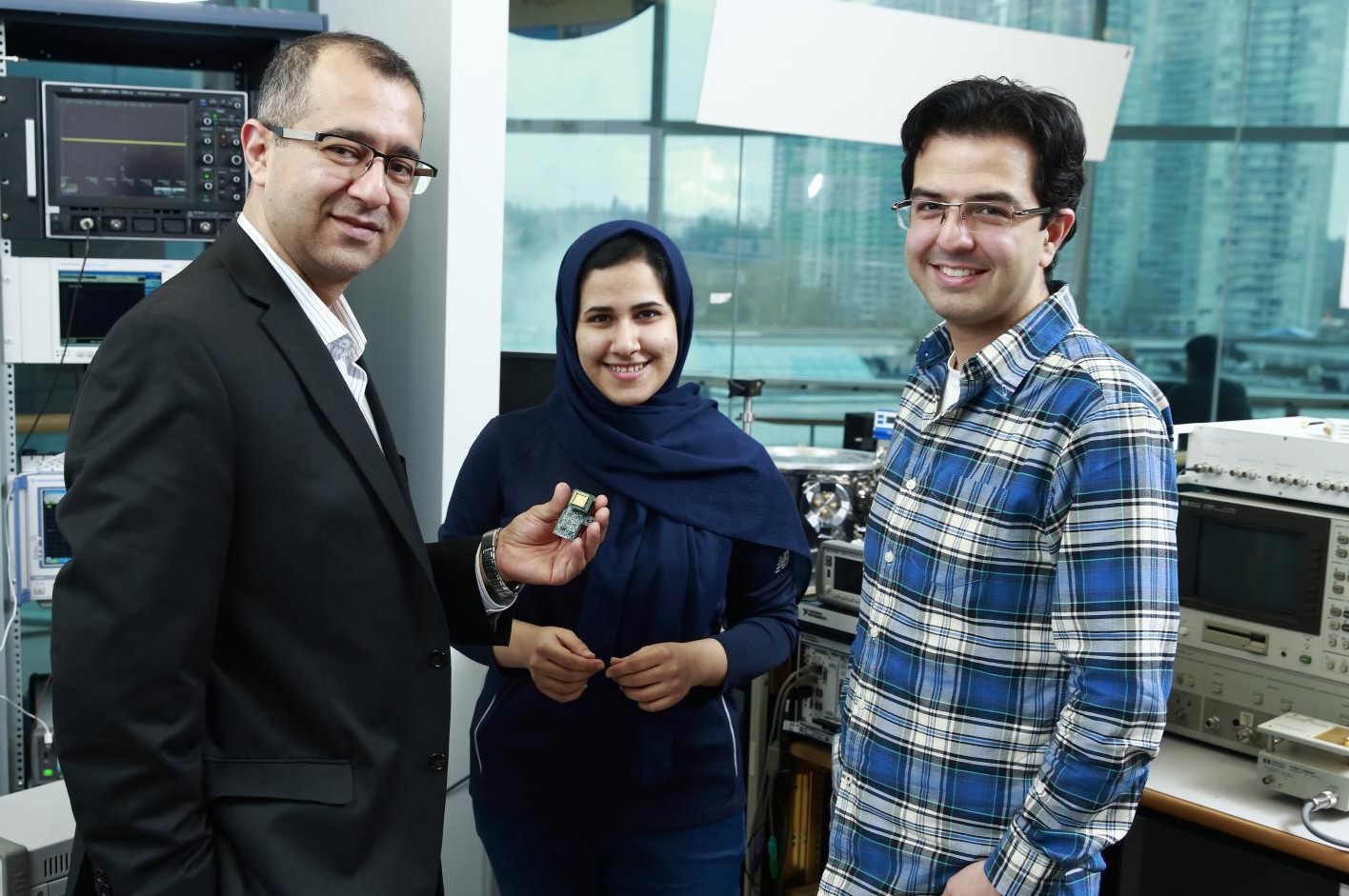
Small, sensitive sensors sound out new markets
Developing ultra-sensitive vibration sensors for a global defence company enabled microsensor
innovator Dr. Behraad Bahreyni (left) and his team at Simon Fraser University to identify new commercial
opportunities—and establish an award-winning startup company—for advancing their technologies into
civilian applications.
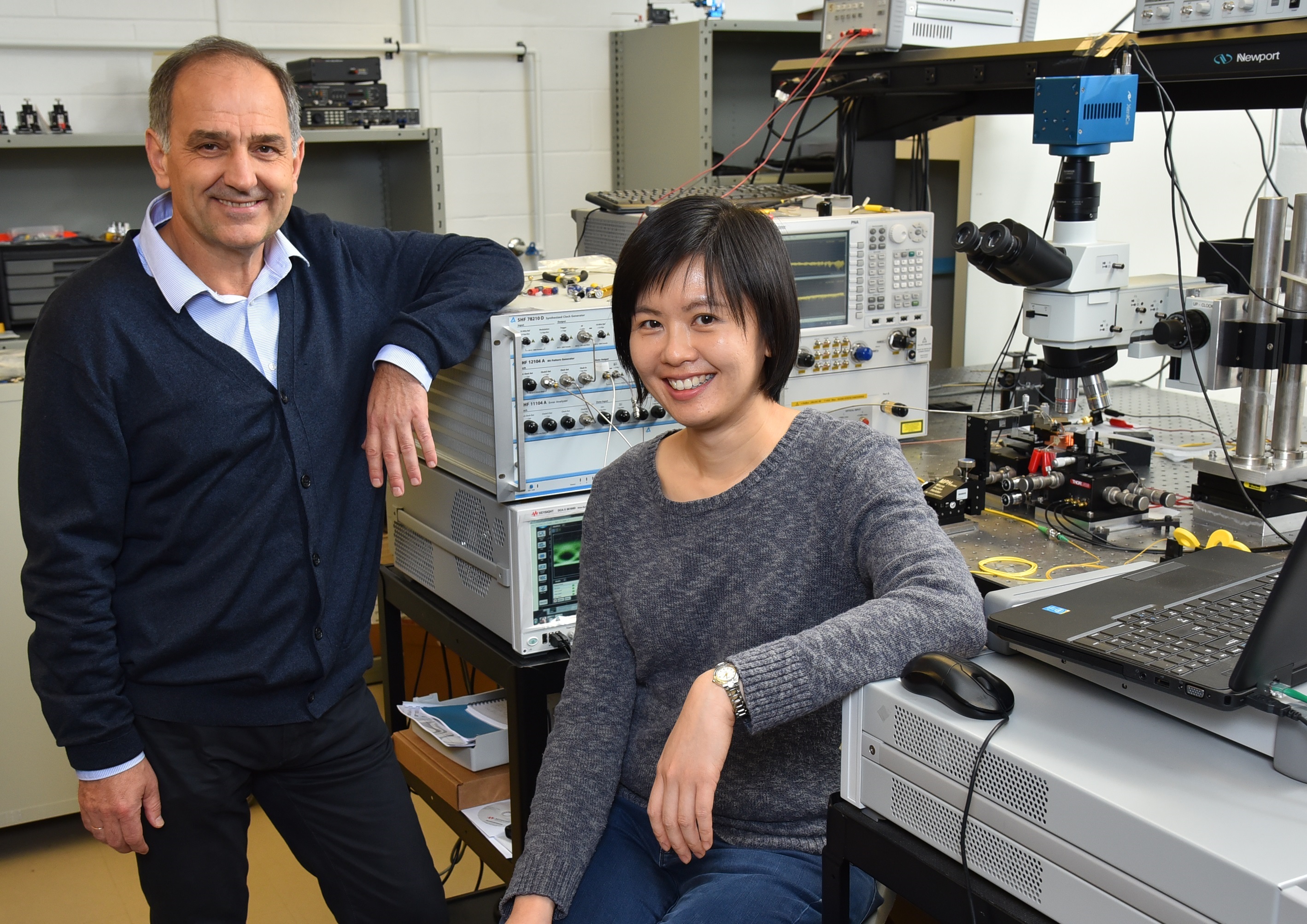
Global conference recognizes made-in-Canada photonics innovations
Joyce Poon, Sorin Voinigescu and their teams solved a significant problem in short-distance optical communications with their development of a 3-D integrated transmitter using a CMOS driver. Their novel solution combines the advantages of high performance and low power consumption with low-cost, established manufacturing processes.
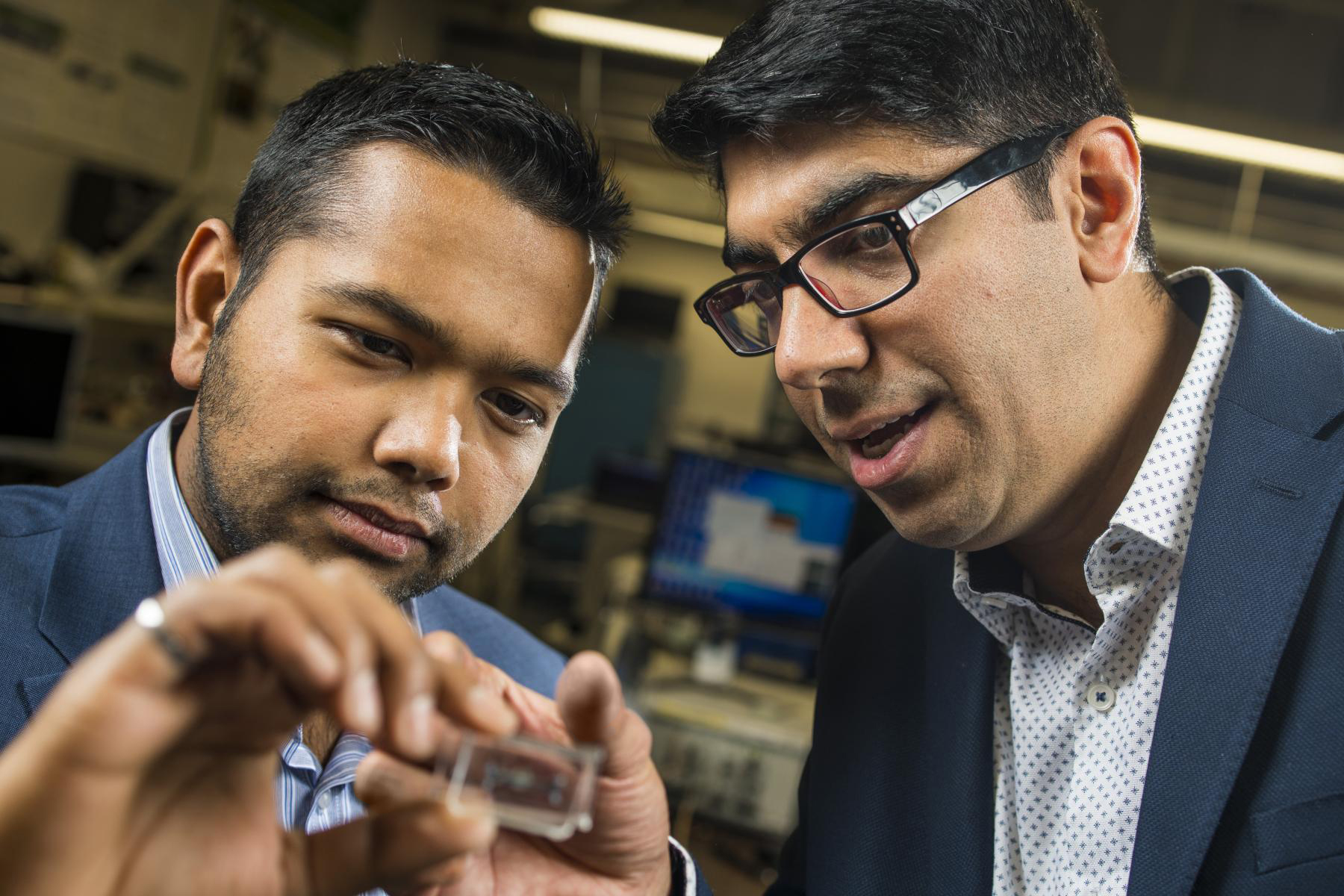
New direction for a dependable dish
Neil Roy Choudhury and Hamid Sadabadi, Concordia University graduates, leveraged their mutual expertise and interest in microfluidics and biosensing to create their Calgary-based startup, Frontier Fluidics. Experience using advanced design tools and industrial manufacturing processes is enabling them to create next-generation labs-on-a-chip that mimic real-world environments, customized for innovators doing a broad range of research and experimentation.
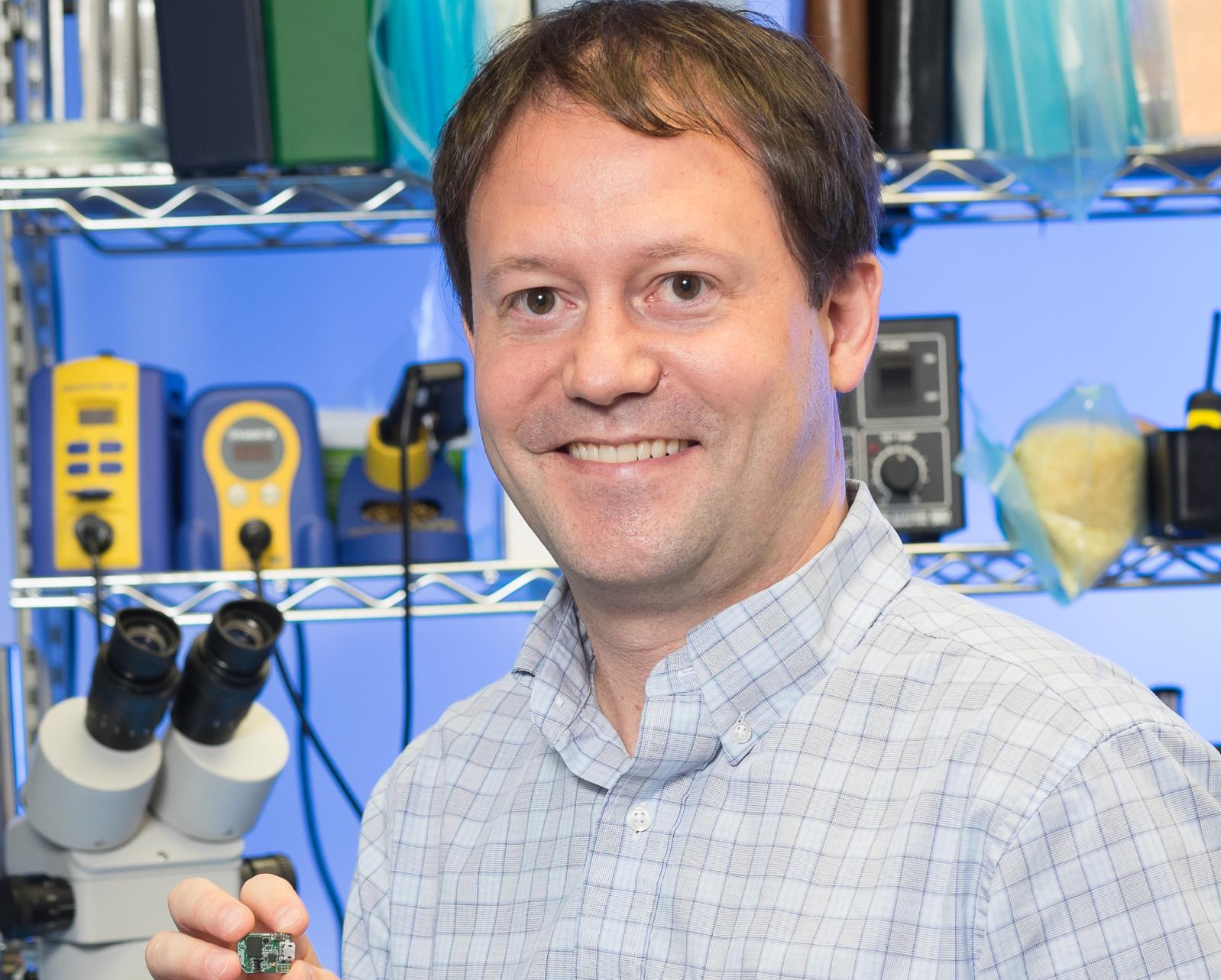
Integration innovation: Low power, high function
Dr. Jean Samuel Chenard’s graduate student research more than a decade ago into integrated, networked technologies anticipated the Internet of Things. Today, Motsai Inc., the company he founded on his research, develops specialized, sophisticated technologies for wearable device and telecommunications markets.
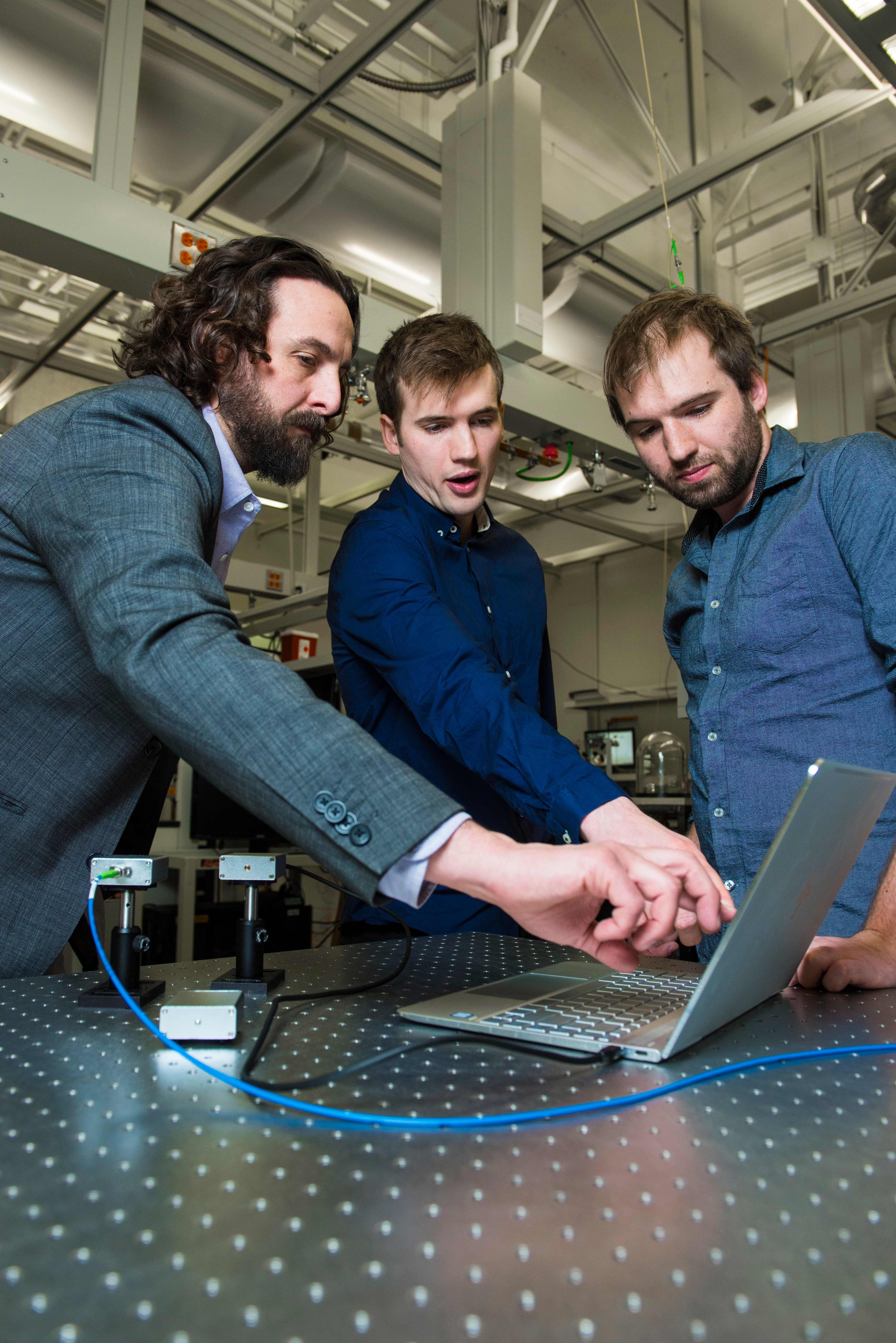
Resolving a Quantum Conundrum
Nanomechanics specialist John P. Davis (left) and his students Pearse
and Callum Doolin developed the first digital photodetector capable of
measuring the quantum properties of nanomechanical systems. Their
instrument, now on the market through their startup company Resolved
Instruments, opens up new opportunities in the emerging field of quantum
technologies.
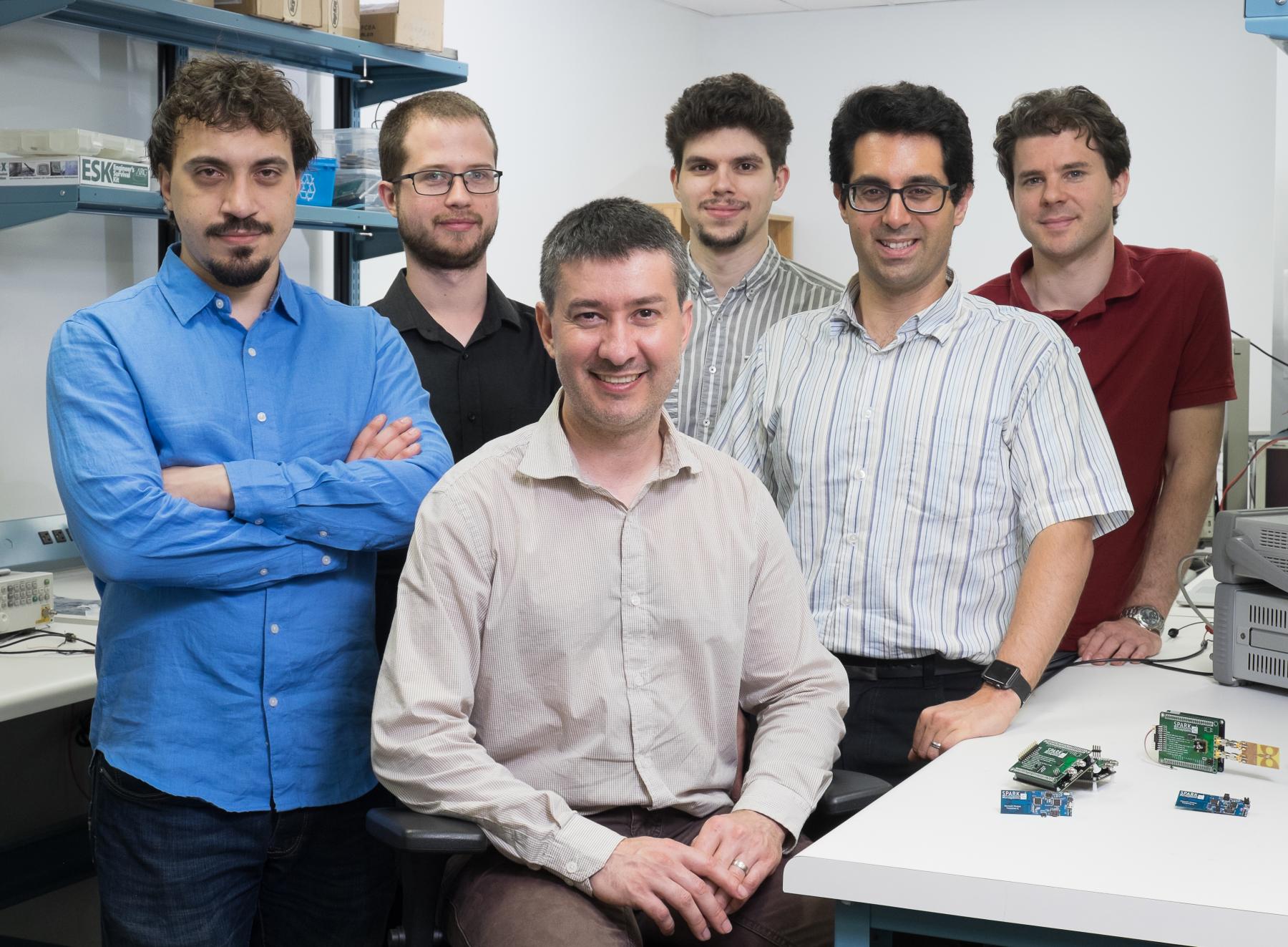
Novel transceiver paves the way for a battery-less future
A fresh approach to wireless transceiver design has helped École de technologie supérieure professors Frederic Nabki (bottom right) and Dominic Deslandes (bottom centre) develop a new technology with dramatically lower energy requirements, offering potential for devices that never need recharging Their chip is now being commercialized by their startup company, SPARK Microsystems. Other team members, from left to right include Rabia Rassil, Antoine Collerette, Gabriel Morin-Laporte and Michiel Soer.
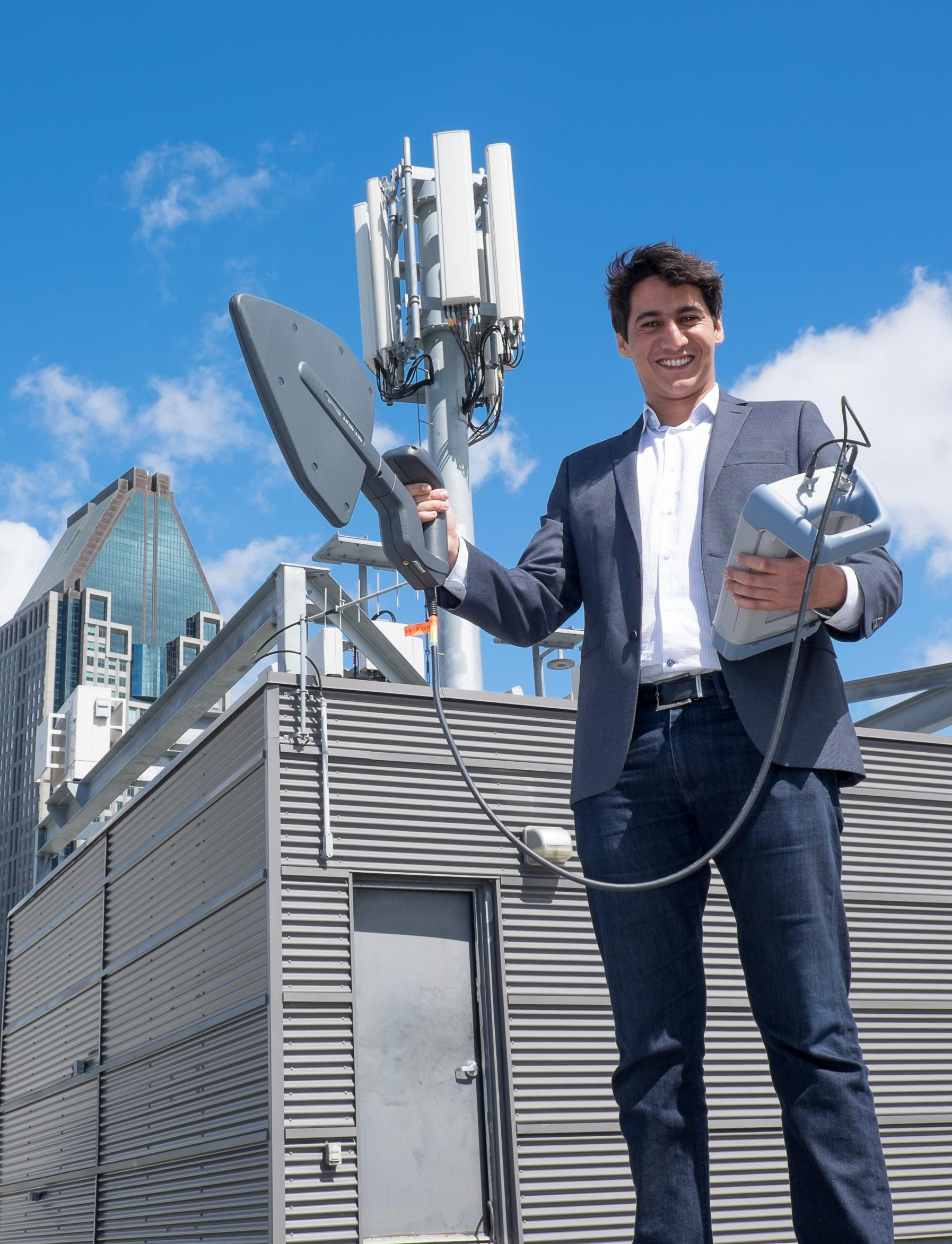
From the battlefield to the boardroom, new solutions for wireless communications
A state-of-the-art wireless communication solution developed for the Canadian military by Sofiane
Bounaffaa and his graduate supervisor Francois Gagnon (École de technologie supérieure) formed the
basis of a startup company that is helping companies and institutions improve the performance of their own
communications systems.
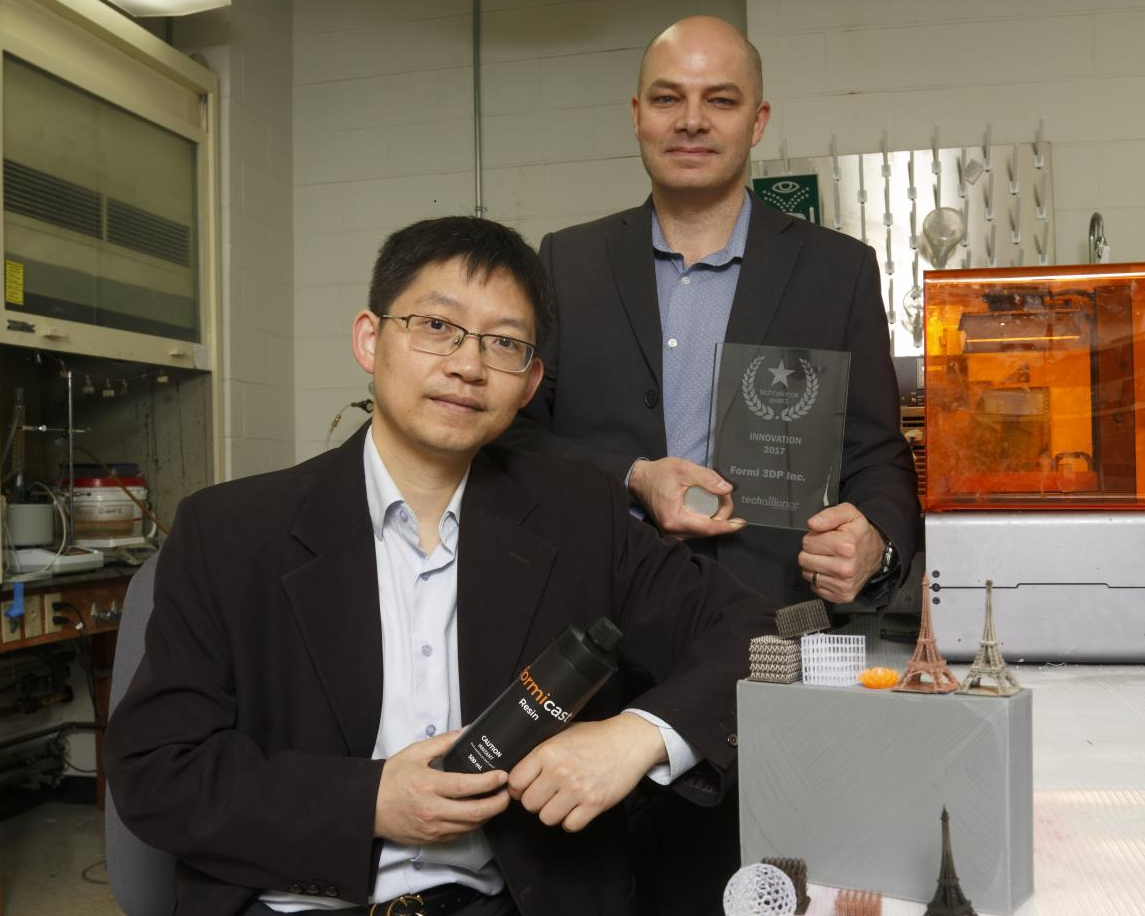
Formi 3DP: Spawning the ‘stem cells’ for circuitry
Western University’s Jun Yang (left) uses surface chemistry to modify and add functionality to materials through initiator-integrated 3D printing (i3DP). Formi 3DP, his startup company co-founded with assistance from Patrick Therrien (right), uses this novel, low-cost process to develop polymer “stem cells” capable of creating 3-D objects with user-defined properties, and holds promise for the efficient production of complex electronic circuitry.
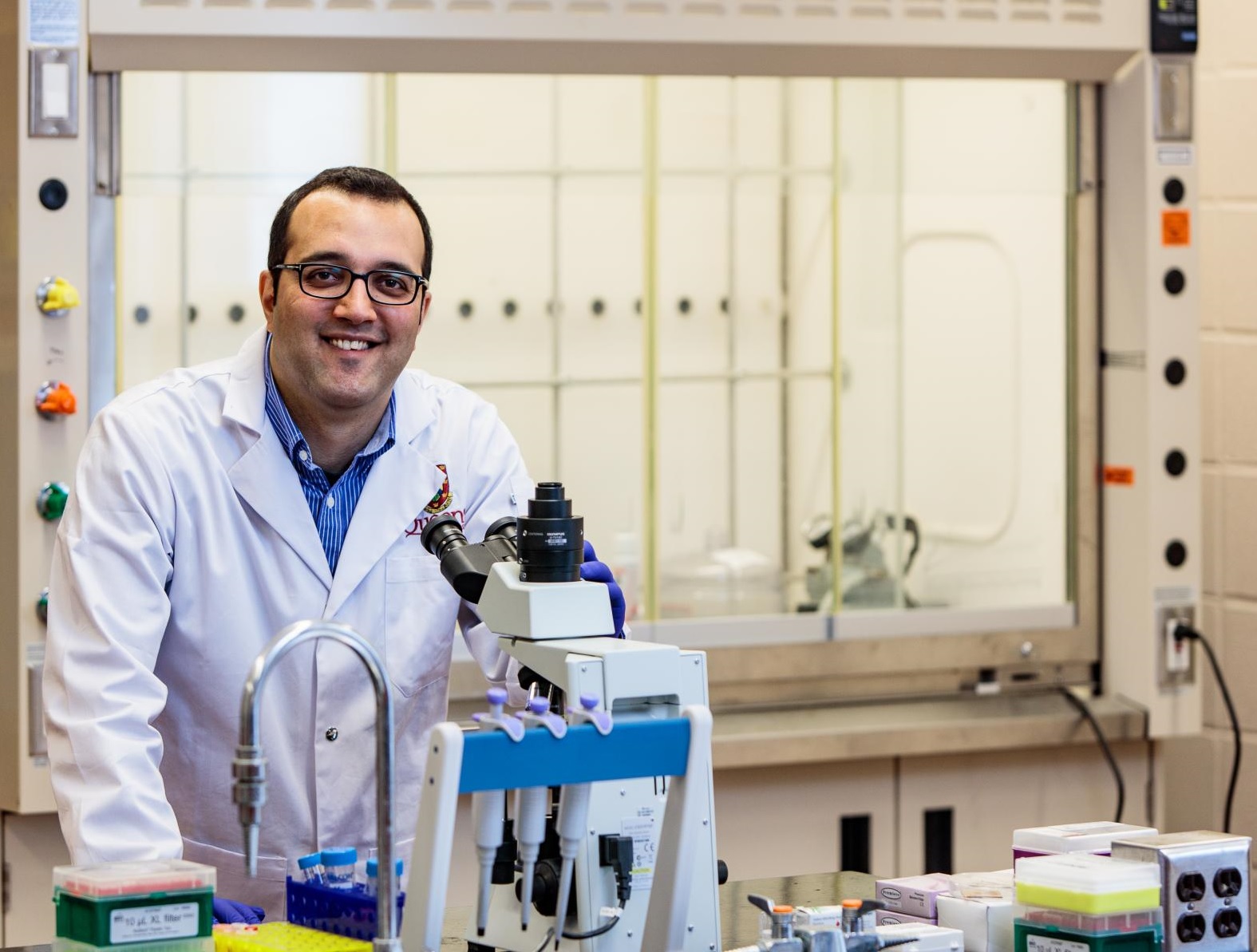
Channeling new approaches to assisted reproduction
For infertile couples, the expense, duration and low success rates of assisted reproduction can make the process a physical and emotional ordeal.
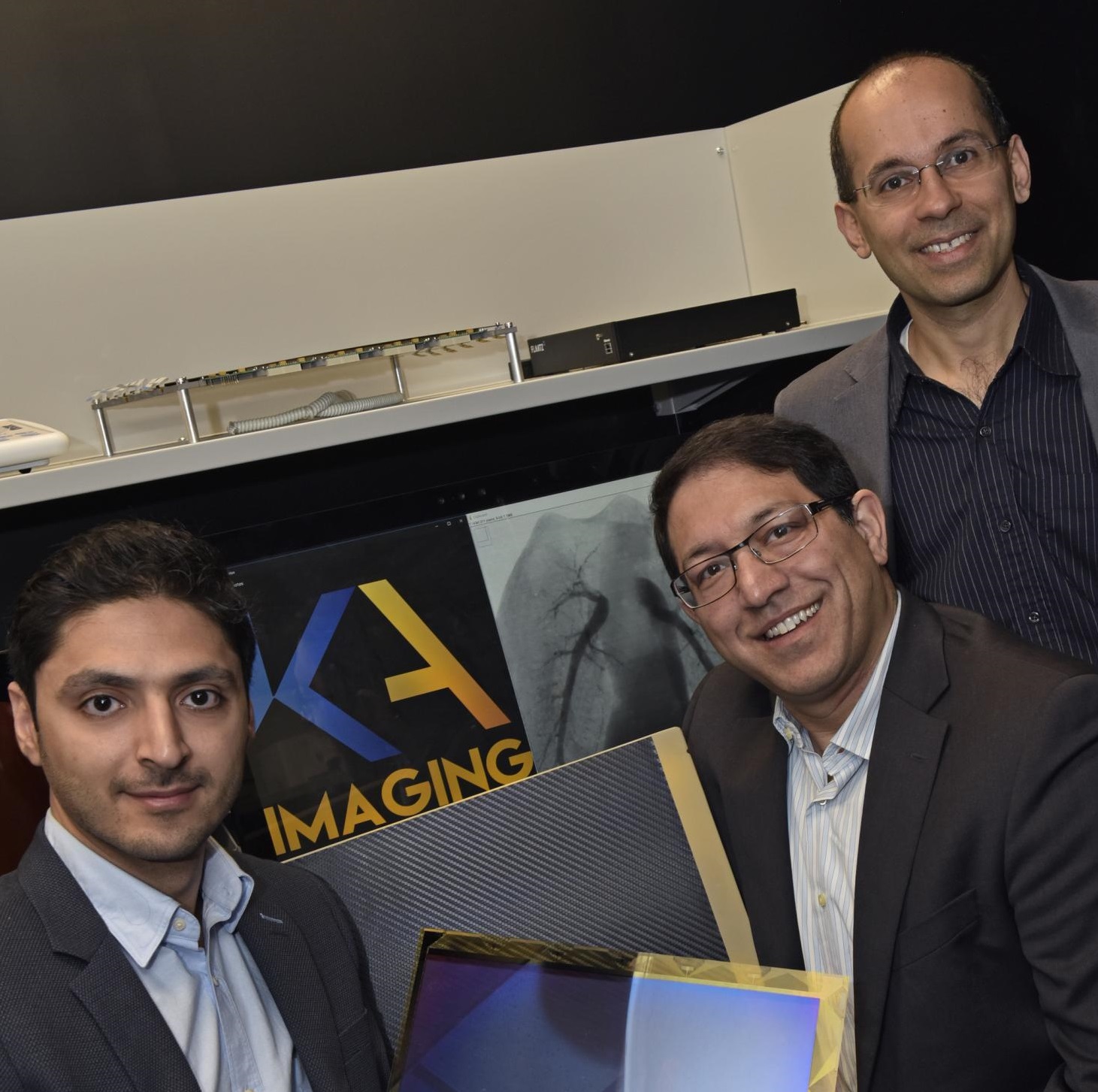
Reinventing X-ray technology
University of Waterloo innovator Karim Karim (far right) and his team combined existing LCD technology
and manufacturing processes with a unique electronic architecture to create better, safer and lower-cost
X-ray imaging. Their technology offers the potential to improve disease screening and diagnosis worldwide,
especially in remote and underserved communities.
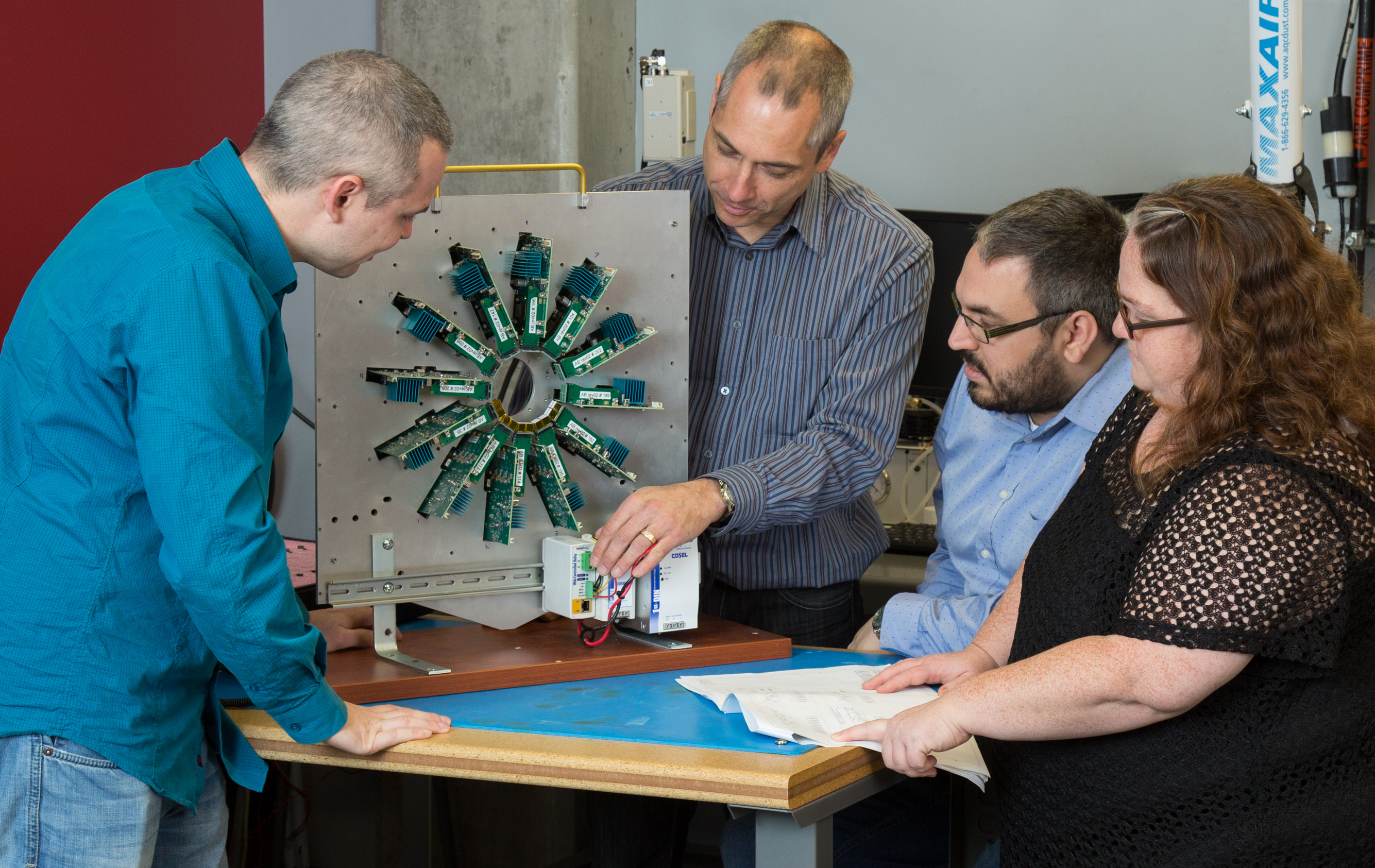
Small scanners offer big advances
Dr. Réjean Fontaine and his graduate students at Université de Sherbrooke examine the detection system
of their novel LabPET II small-animal scanner. Data-acquisition capability integrated within the system
enables imaging with unprecedented contrast-to-noise ratio and spatial resolution. The technology has earn
multiple awards for his graduate students.
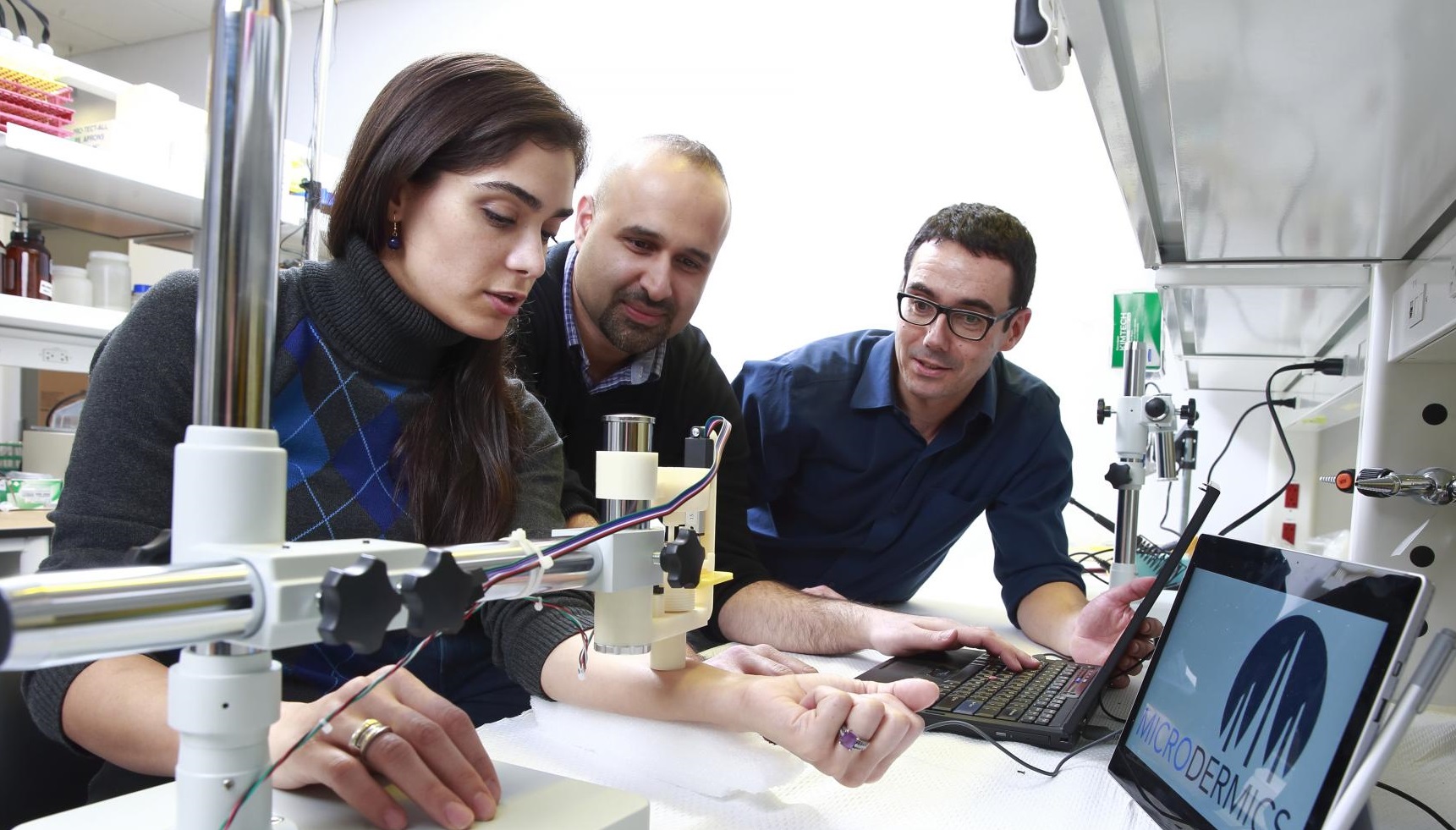
Taking the sting out of injections
Dr. Boris Stoeber (right), professor at University of British Columbia, is redefining drug delivery through the
development of painless, hollow metal microneedle arrays that barely penetrate the skin. More recently,
he and his team have integrated optical sensing properties into these arrays, offering a faster, cheaper and
less invasive alternative to hypodermic-based blood sampling for drug monitoring. Founder of microneedle
startup Microdermics, he is shown here with company co-founder Iman Mansoor (centre) and Dr. Mehrsa
Raeiszadeh (left), Microdermics employee.
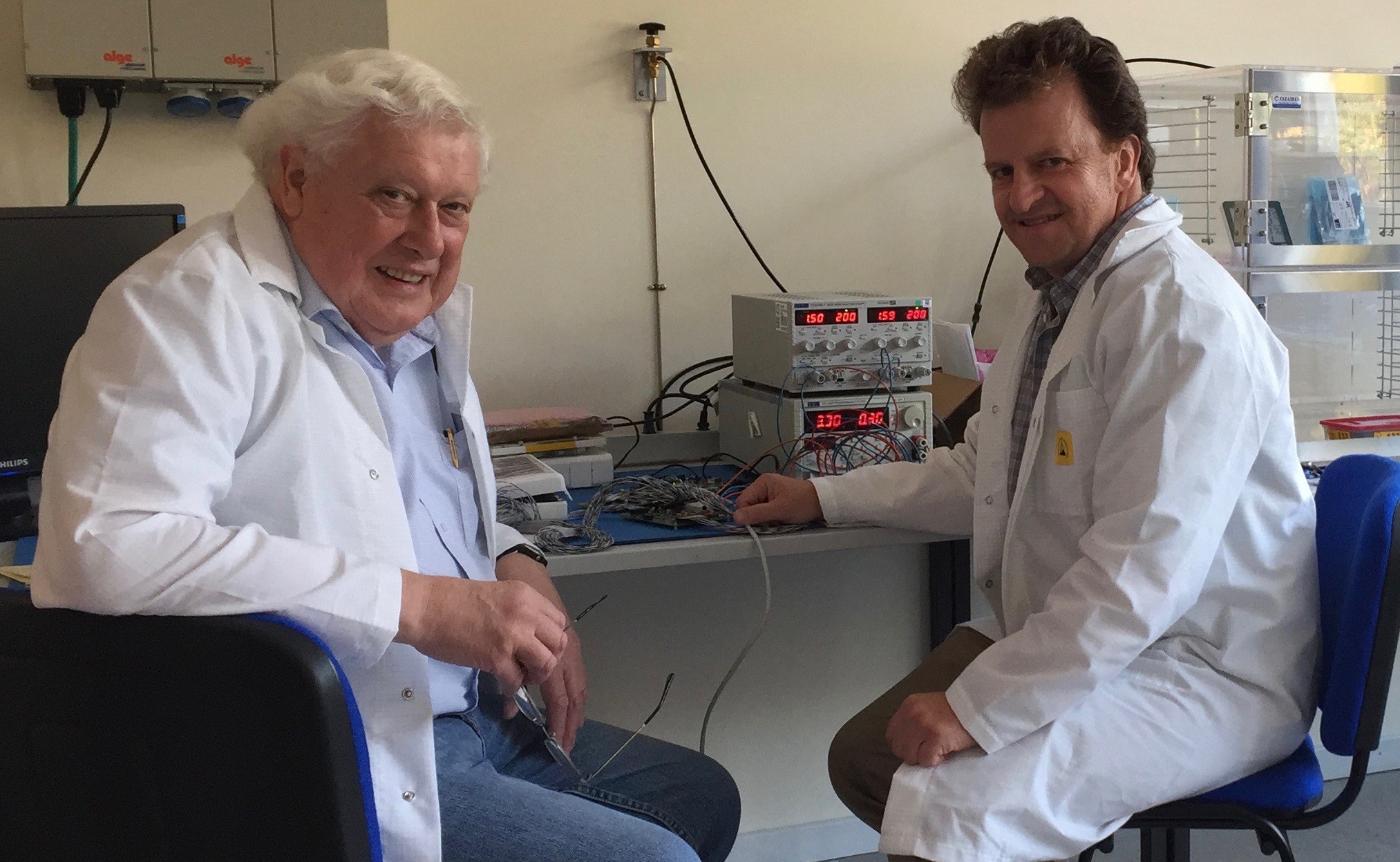
A new heart for ATLAS—with help from Canadian innovators
Tasked with upgrading the thousands of complex sensors that help drive the world’s largest and most powerful particle accelerator, U of T researchers Dr. Richard Teuscher (Institute of Particle Physics – IPP) (right) and Dr. Robert Orr (left) found the expertise they needed in Canadian company Celestica.
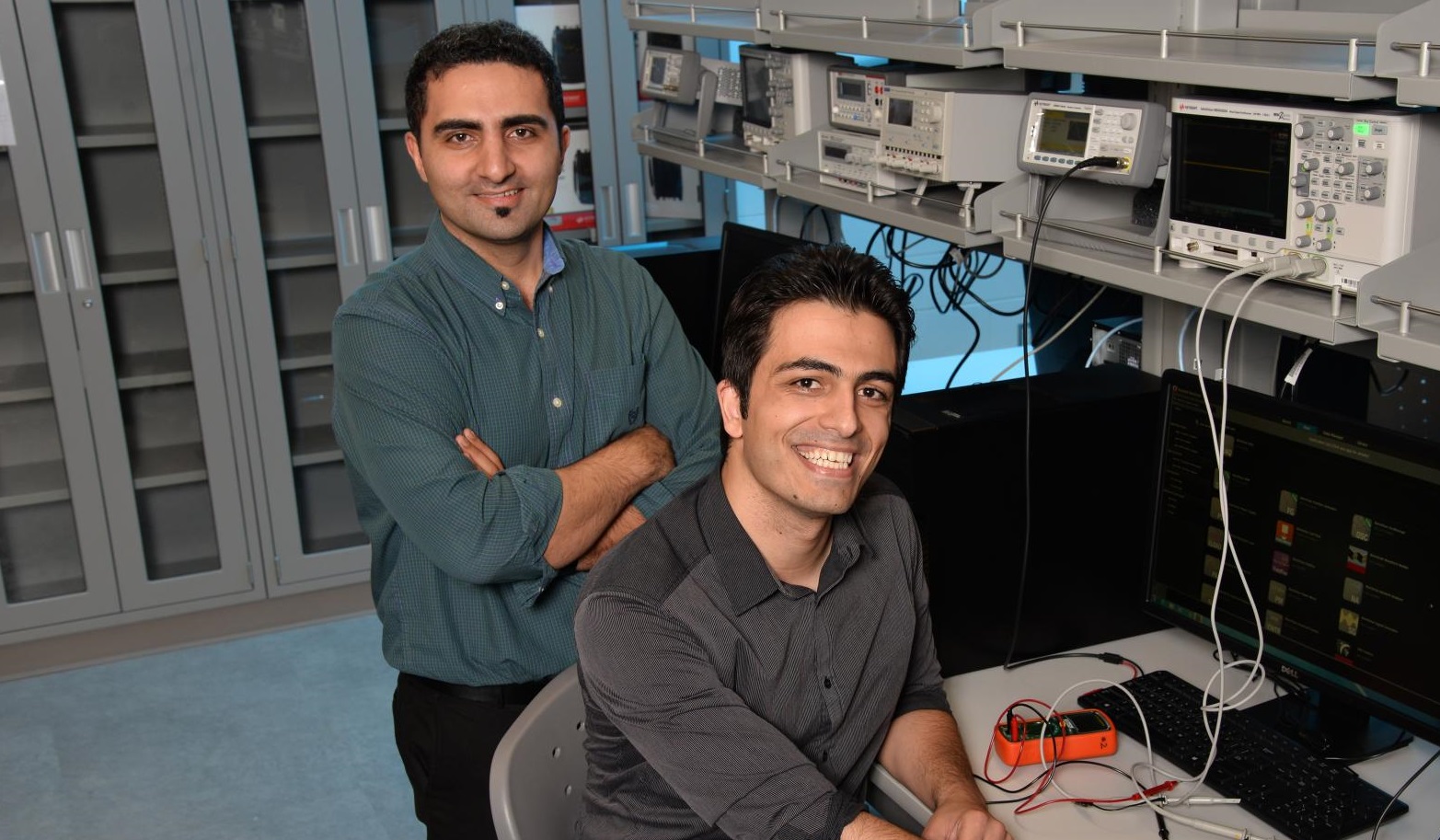
Micro-device offers potential to stop seizures before they start
Academic entrepreneur Hossein Kassiri (centre) developed an implantable device with micro-EEG capability
to actively detect and prevent epileptic seizures. His technology is now being commercialized through
Braincom, a startup company he created with business partner Nima Soltani (left).
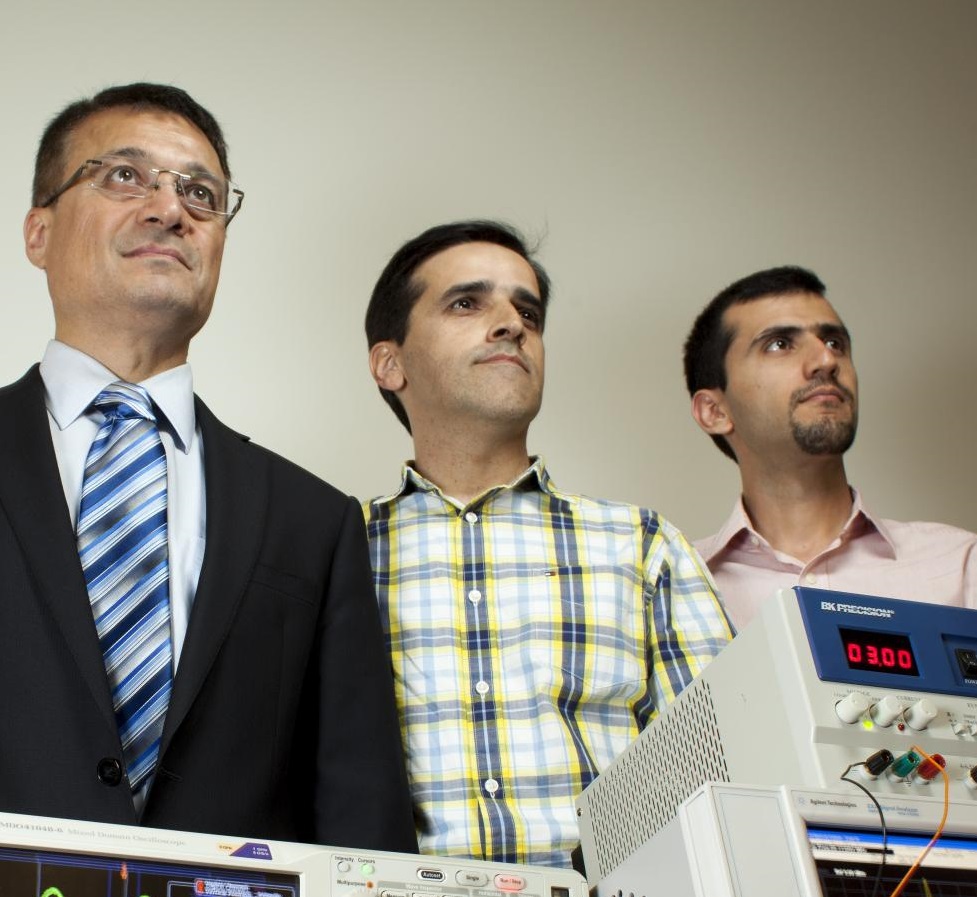
Measuring success by the micrometre: Industry-university collaboration helps automotive companies innovate
Rashid Rashidzadeh, adjunct professor at University of Windsor, and his students helped Canadian automotive supplier Landau Gage address a key productivity barrier for parts manufacturers while developing highly skilled innovators for the advanced technology manufacturing sector
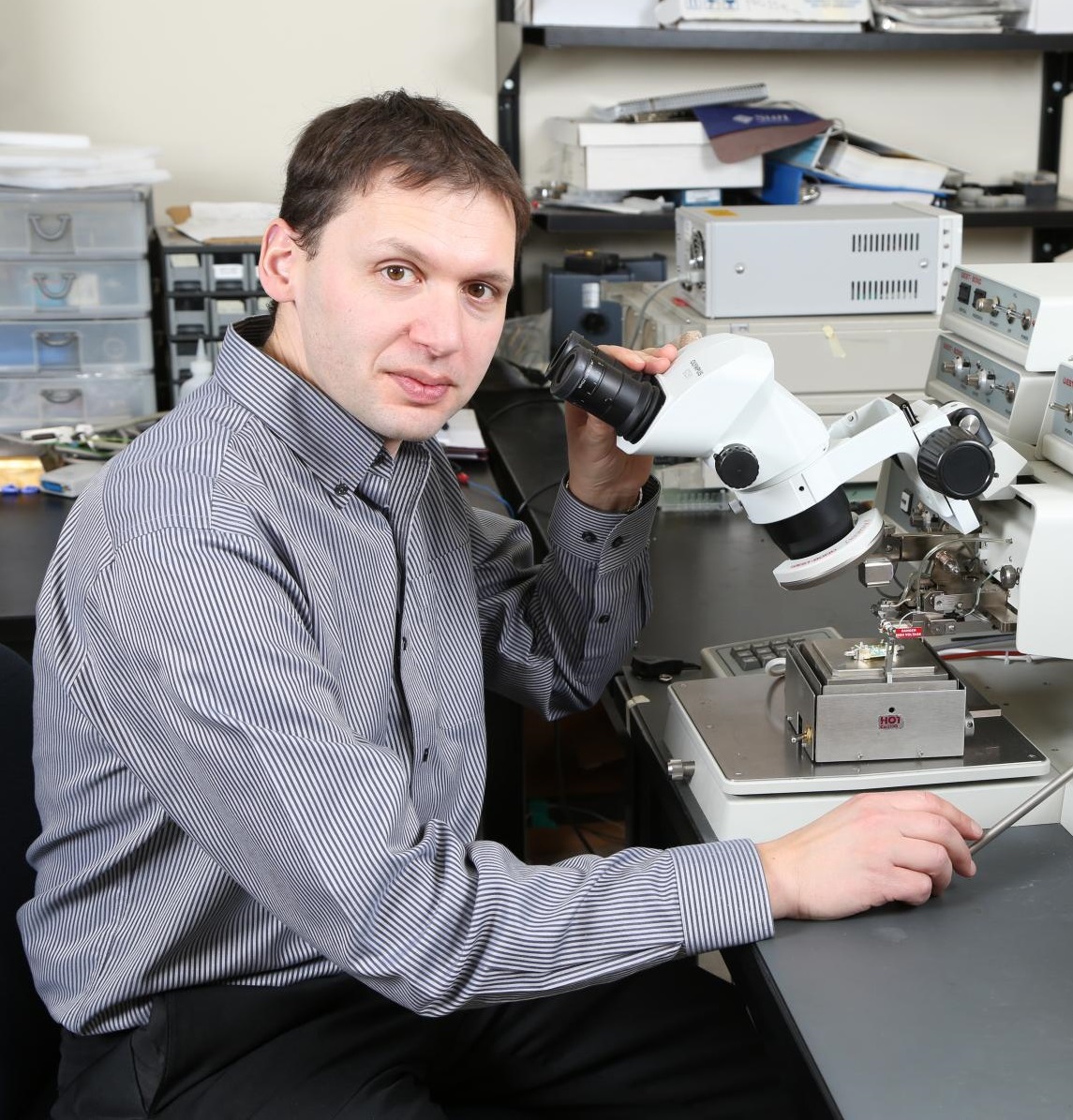
Novel receivers target world’s largest radio telescope
Dr. Leonid Belostotski’s pioneering development of focal plane arrays with low-noise receivers is solving a
major problem in cosmic research while creating novel technologies with broad commercial potential. The
University of Calgary researcher’s work is part of a global effort to build the world’s largest radio telescope
for transformational research into the evolution of our universe.
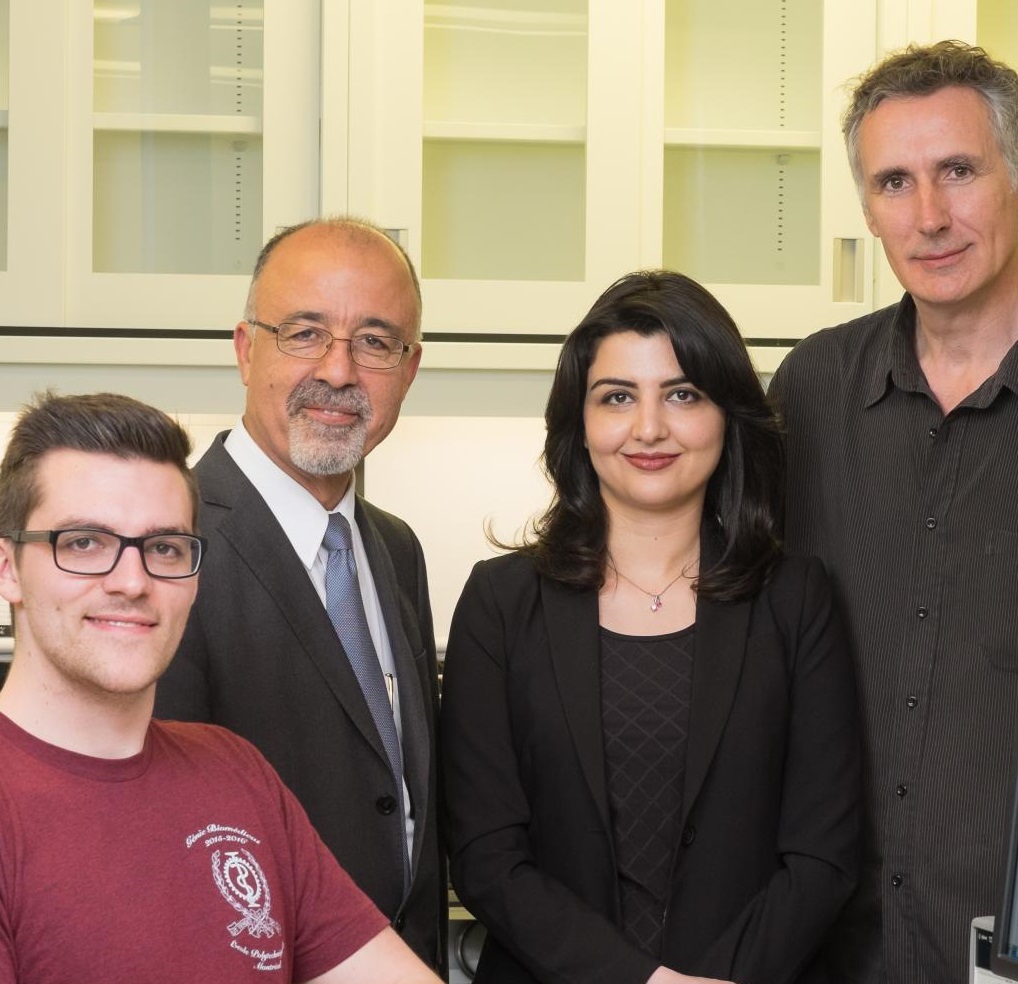
Thinking outside the chip: Researcher’s smart petri dish solves biosensor challenge
Ghazal Nabovati (centre right), PhD candidate at Polytechnique Montréal’s Polystim Neurotechnology Lab, successfully integrated biology, chip design, electronics, software and mechanical prototyping to develop a novel cell imaging platform that makes cell analysis simple, fast and automatic.
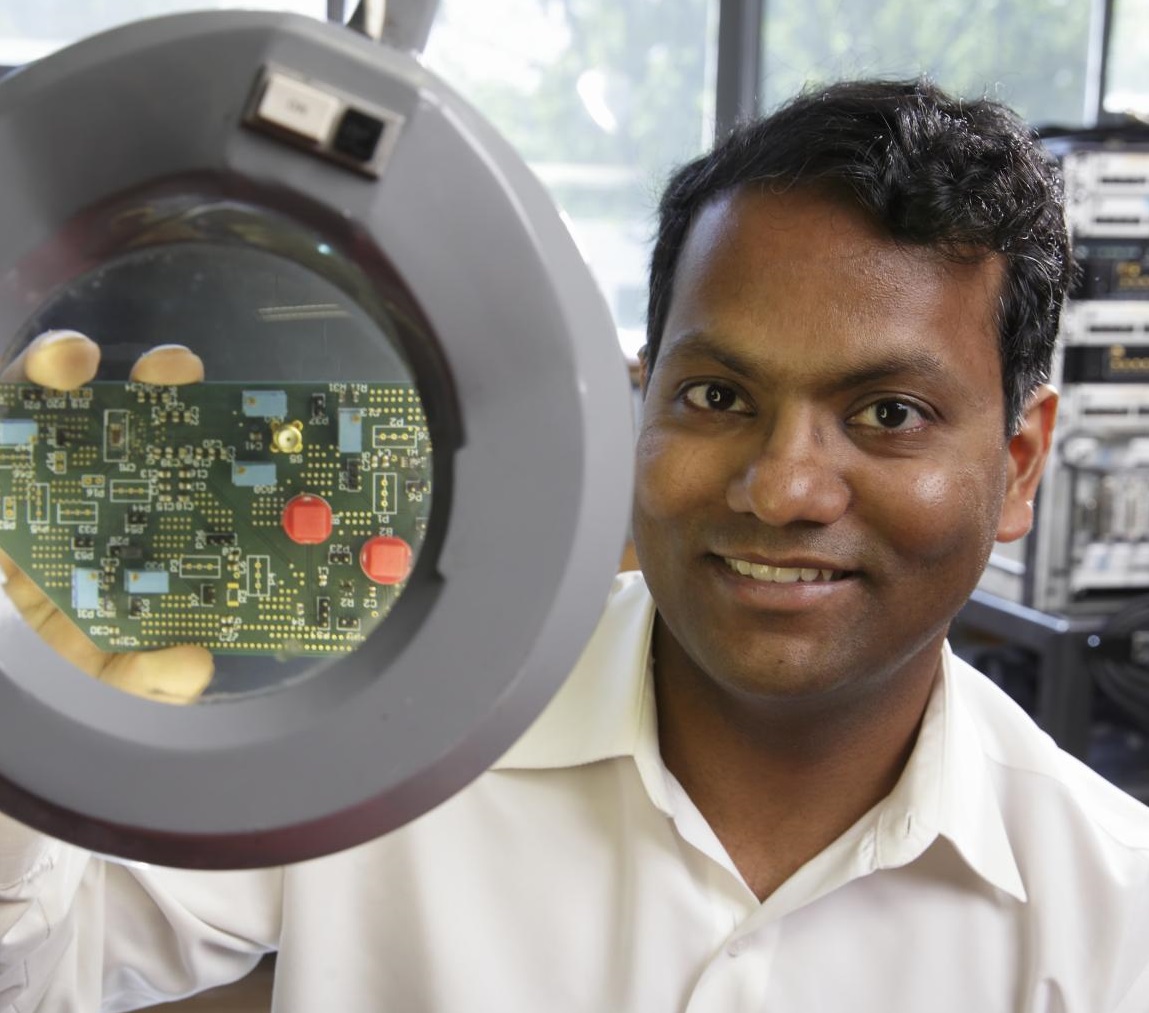
Integrated R&D community attracts innovative chip designer to Canada
The opportunity to nurture new talent and share technology innovation via Canada’s National Design Network proved irresistible to industrial research scientist Sudip Shekhar. Now assistant professor in electrical and computer engineering at University of British Columbia, the former Intel employee left the U.S. to pursue research innovation in silicon photonics while mentoring students in this emerging field.
